The Impact of Company Brand Culture On Driving Performance and Increasing Sales
/2 Comments/in Brand Culture, Brand Experience, Brand Innovation, Brand Loyalty, Brand Positioning, Brand Profiling & Positioning, Brand Refresh, Brand Relaunch, Brand Revitalisation, Brand Values, Rebranding /by Lorraine CarterMost leaders and employees would view company brand culture as a crucial part of job performance and satisfaction coupled with great customer service, yet for so many brands it remains an elusive concept.
We all know intuitively that a bad company culture produces bad results and there are plenty of statistics to back this up. One Columbia University study shows that the probability of job turnover when a brand’s company culture is poor is 48.4%, compared to just 13.9% when the brand culture is perceived as a good one.[1]
In fact, good corporate brand culture fundamentally drives financial performance as evidenced by the research published in the book ‘Corporate Culture and Performance’ by HBS Professor James Heskett and Kotter International[2]
| GROWTH | Average Increase for Twelve Firms with Performance-Enhancing Cultures | Average Increase for Twenty Firms without Performance-Enhancing Cultures |
| Revenue Growth | 682% | 166% |
| Employment Growth | 282% | 36% |
| Stock Price Growth | 901% | 74% |
| Net Income Growth | 756% | 1% |
“Great companies that build an enduring brand have an emotional relationship with customers that has no barrier. And that emotional relationship is the most important characteristic, which is trust.”
Howard Schultz, Starbucks
Culture matters because it’s about transparency, company behaviour, what you stand for, who you are. Brand Culture is how you convey, share, and translate that into your brand. It’s what every employee believes, does, and lives to express that culture.
Brand culture is driven by the fundamentals of your brand profiling i.e. what your brand stands for, it’s personality, mission, vision, values, purpose and way of doing things.
It’s about building a relationship between your culture, which may be developed over time but should ideally be guided from the top, the founder, owner or CEO — the visionary behind the brand — and your brand itself in terms of its personality, how it does things, the customer experience it creates and what it stands for. How you develop them to create a strong positive and distinctive brand experience.
Related: CEO Brand Leadership, How Vision Drives Brand Growth
There are also bad cultures within businesses and organisations which are not positive brand experiences. These poor brand cultures undermine performance, productivity, the whole perception of the organisation, the brand and negatively impact sales.
Our experience working with many different companies and organisations across diverse sectors clearly illustrates that it’s not that they haven’t considered company brand culture, it’s that developing and implementing something perceived to be so abstract can be difficult.
Related: Top 10 Brands for Customer Experience and What You Can Learn From Them
Because of this apparent client challenge we’ve pulled together some tangible ways you can start working on and developing your brand culture together with case studies from worldwide brands to show you ‘brand culture’ in action in the ‘real world’.
They’re brands who, like us, understand that building culture is not about placing a ping-pong table in a rec room, it starts with strong brand values that respect your employees and customers alike.
12 Ways To Improve Your Company’s Brand Culture so You Increase Performance and Grow Sales
1. Don’t be Afraid to Mix Marketing with People
Based in Kansas and proud of its community roots, CornerBank, now part of RCB Bank, describes itself as the bank that is “on your corner and in your corner”.[3] Their approach to culture and marketing lies in people, something which RCB Bank is trying to emulate since their merger last year.
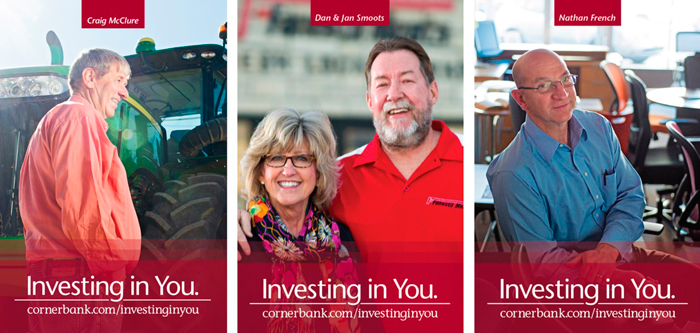
Image via CornerBank
CornerBank practised what they preached by combining the head of HR and the head of marketing into one role because their “people are their best marketing tool”.[4] While it’s undeniably an unorthodox way of structuring a company, in doing so, they put faith in their staff, and most importantly, their staff’s commitment to upholding those community roots. It’s a company that looks out for the little guy and ensures that its employees identify strongly with this.
2. Bridge the Gap Between Employee and Customer
With a client retention rate of a near-perfect 97.8%, bank and insurance provider, USAA is one of the most reputable and trusted brands in America.[5]
They have a unique proposition in that the vast majority of their customers are active or retired US military. No one knows their customer better than USAA and the company instils this in their employees by training them in the experiences of a soldier.[6]
This works in two ways. Firstly, for company culture, it gives employees insights that help them do their job better, which improves job satisfaction, and challenges them in the right way. And secondly, it shows customers that their experiences are genuinely important to the brand as a whole, but also that the people who they reach out to for service are much better equipped to deal with their situation. For soldiers trying to do their banking from war zones, that is often a pretty unique one.
3. Foster Fun and Creativity
When you think of best practice company culture, tech companies tend to come to mind. They seem to understand the important connection between having fun and innovating. Squarespace embodies many of the principles of best practice company culture – an attractive office space, very few levels of management, celebrations, downtime and flexibility.
What’s important here is that these practices stem from the company’s respect for its employees. This is the approach we take when we are working with clients. Downtime and flexibility show employees that they are respected enough to get on with their job and exercise a certain amount of autonomy.
Related: Use Humour in Branding to Create Strong Emotional Bonds so You Increase Sales
The fun aspects of this company’s culture are layered on top of this to let employees know that their work is appreciated. This two-pronged approach ensures that your company brand culture is engrained as a real living experience for everyone and not just lip service.
4. Offer Flexibility
Flextime is not a particularly new concept, and you’ll find it especially prevalent in public service organisations and progressive companies in western countries. Because of this, extensive research has been conducted to measure the value of offering this to your employees.
A survey conducted by The Alternative Board (TAB), an international provider of executive peer advisory boards, of hundreds of business owners, found that business owners who thought that their company culture was ‘strong’, also offered their employees flexible conditions, particularly in terms of time and remotely working.[7] We tend to find that when workplaces concentrate on results, project completion, and quality of work, the perceived ‘drudgery’ of the 9-5 work culture is eliminated, and employees feel part of something bigger which engenders a greater sense of job satisfaction.
Medium-sized British activewear company, Sweaty Betty, embodies these principles by using open communication and showing that they understand their employees have life commitments in addition to their work ones. “We trust our team and operate on a flexi-hour policy,” says Jessica Howden, people and events coordinator. “If a team member would rather leave earlier in the afternoon because of a long commute, they can start earlier in the morning. Our working hours are not set in stone.”[8]
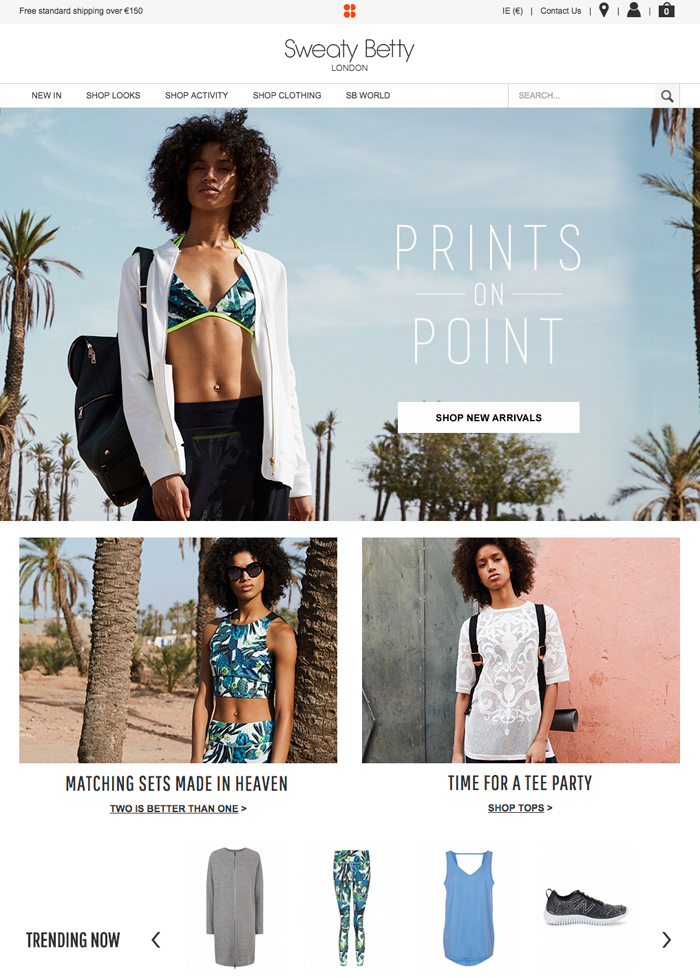
Image via Sweaty Betty
5. Build Brand Relationships to Create Community
Ask any social scientist, the key to happiness among employees in a workplace is when they feel like they are part of something bigger that makes a difference. Apple and Nike exhibited this in their September 2016 keynote where they teamed up to introduce the second-generation Apple watch. This is a watch that allows people to be part of two tribes – the Apple tribe, and the Nike Running Club tribe.
Aligning with another brand that commands respect and complements your brand values and positioning promotes inclusivity in your workplace and makes your employees feel like they are part of something larger than themselves. It also strengthens your brand in the mind of your customer and leads to commercial growth – advocates of one brand will be more likely to become advocates of the other when they are aligned.
When we work with companies to identify co-branding opportunities, having a strong brand culture or value fit is essential. Some of the most effective brand collaborations and alignments are not even necessarily in the same industry. This can yield great results for SMEs where the primary focus is to stand out, increase brand awareness with sales and reach new audiences.
Related: Co-Branding, 13 Tips for Growing Your Brand Through Strategic Partnerships
6. Hire ‘Your’ People
Traditional recruitment is generally based on skills and experience. Our approach to recruitment for your brand is to ascertain a baseline level of aptitude that you would consider mandatory, and place more emphasis on finding a suitable fit with your organisations brand culture.
Recruitment companies, such as New Zealand-based company, Weirdly, take an innovative approach to recruitment using a series of tactics to assess a potential employees culture fit before they even get to the interview phase. In doing this, you create a workplace where people feel a sense of belonging, as well as the crucial creation of an environment where ideas can be shared.
7. Employees as Brand Ambassadors
As we’ve mentioned, most companies will try to hire employees who reflect and embody their company’s values in some way. Increase engagement with your brand and create authentic communication by making it attractive for your employees to become brand ambassadors.
According to the 2016 Edelman Trust Barometer “Employees rank higher in public trust than a firm’s PR department, CEO, or Founder. 41% of us believe that employees are the most credible source of information regarding their business.”[9]
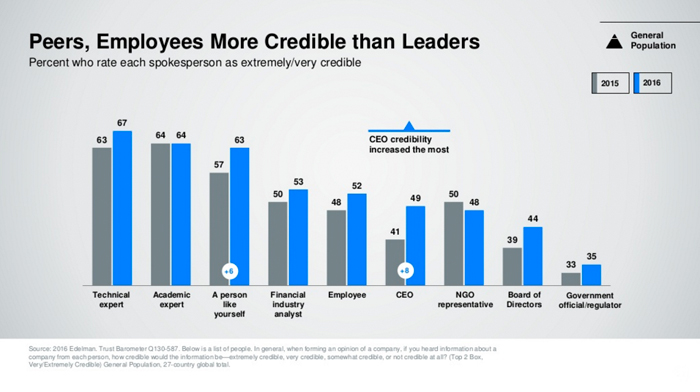
Image via Edelman Insights
We believe that this likely stems from the perception that employees are much more likely to voice their honesty, particularly if they are disgruntled. An employee that is openly endorsing a company is viewed as a trustworthy and reliable opinion. Social media is a great platform to try this on. Creating environments where employees feel compelled to share the goings-on of their workplace on their personal channels speaks volumes, and is a great place to start.
American-based retailer, Zappos, has an infamous reputation for its focus on employee culture. “At Zappos, we really view culture as our No. 1 priority. We decided that if we get the culture right, most of the stuff, like building a brand around delivering the very best customer service, will just take care of itself.” Tony Hsieh, CEO, Zappos–January 9th, 2010, The New York Times[10]
Related: Brand Sponsorships: The Best Brand Ambassadors Are Already On Your Payroll
8. Give Your Audience a Sneak Peek into Your Culture
In a similar way, don’t be afraid to shed a little light on how great your company is behind the scenes. Doing so increases your brand value with your customers and gives employees a public reason to feel proud of where they work. Your customers could also be your potential employees.
Just ensure that what you are posting accurately reflects your brand values as a company and how you want people to perceive it. ASOS is a great example of this – they use their Instagram account to provide sneak peeks into their workplace culture. It injects personality into the brand and shows that they value their employees.
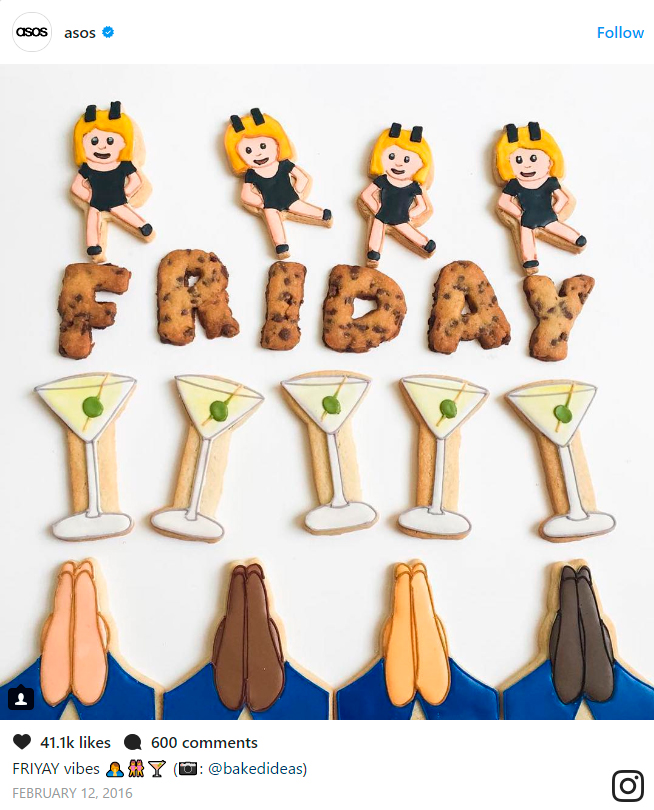
Image via ASOS on Instagram
9. Remove Restrictive Hierarchies
Hierarchies are a particularly tricky area of company politics to navigate. We tend to look at hierarchies not from a ‘have them/don’t have them’ perspective, but rather explore why you have them, what purpose they serve and, most importantly, whether they are restrictive. Closed door policies can inhibit the flow of ideas and creates an ‘us and them’ culture, which is intimidating and often counter-productive.
While your brand needs a leadership team, and there will be things that the leadership team knows that employees aren’t privy to, there are ways to create an open and flexible environment.
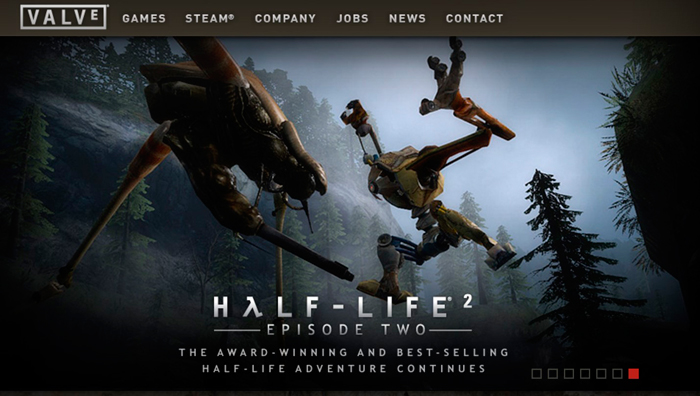
Image via Valve Software
SME, Valve Software[11], does this well – they have no managers, projects are started when an employee can group a team together, and performance management is conducted as peer review. As a result, Valve has experienced tremendous growth – something that would normally require rigidity to manage.
10. Make Your Employees Part of Your Brand Mission
Create an atmosphere where employees feel like they contribute to the outcome of your company or organisation. Environments where staff feel like they are part of something bigger than themselves have been constantly proven to be success-drivers. Results happen when everyone is invested.
So, how do you go about this? Our approach is to create a great brand and strategy communication from the top down. Internal communication should be tailored so that, no matter the structure of your company, each employee knows how they contribute to wider goals, and, most importantly, has a clear idea of what those wider goals are.
Including corporate social responsibility into part of your operations is a great way of tangibly showing both customers and employees that your company is committed to the greater good.
Relate: Brand CSR, The Business Case for Successful Branding and Social Good
Ice cream giant, Ben & Jerry’s, demonstrates that ethics are not just for the realms of small, niche enterprises by only using fair trade ingredients.[12] In strengthening their customer’s positive perception of them as a company, they increase employee morale, drive purchases, and ensure that their brand personality doesn’t fall into the trap of becoming disconnected with consumer’s needs.
Related: Personality Matters: Bringing Your Brand to Life to Grow Profits
11. Give your employees what they need
This is the proof point that your company is not just about placing that ping-pong table in the rec room. Showing employees that you value them and their lives as people, not just workers, vastly increases job satisfaction.
71% of staff at Goldman Sachs feel that they often or almost always receive great rewards, while 82% of American Express employees report that the company often or almost always provides needed training, fair promotions and personally challenging work.[13] While it’s not the glamorous, fun side of company brand culture, creating a base that ensures that your employees know they are valued through things such as child care, mentoring and health, can make a dramatic difference.
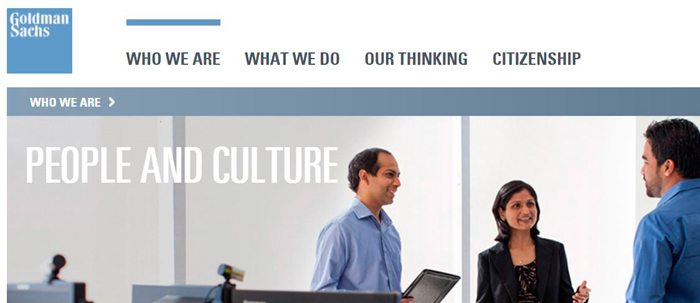
Image via Goldman Sachs
12. Create Autonomy
Career analyst, Dan Pink, has spent much of his own working career studying what it takes for employees to be motivated. It turns out, creating an environment where employees feel that they are the ‘masters of their own destiny’ is one of the most important aspects of employee happiness. This can be relatively easy to establish if the work is naturally project or campaign based, so thought should be given particularly to the roles where work is more constant and not as varied.
For instance, a Web Content Manager at an SME spends their day ensuring that the content is relevant, accurate and appropriate for the company. A company with a poor brand culture will treat this Content Manager as a worker, one who processes and publishes the team’s work, whereas a company with a great brand culture will instil autonomy in the Content Manager. They own the content space, feel comfortable providing advice and direction, and are looked to as the expert in that field. A small change, but one that makes a huge difference.
Related: Family Business Branding and The Secret Drivers to Brand Success
Brand culture integrates itself into every part of your company from the way customers perceive your company and trust you, which in turn has a massive impact on their likelihood to buy and become brand advocates, to your own employees’ sense of job satisfaction.
If you’re struggling to strongly develop your brand culture in order to improve your overall performance, growth and profitability, then a brand audit is a very useful tool to help you evaluate your areas of strength, weakness and potential innovation and growth.
Take a look at our brand audit programme called the Auditing Analysis Accelerator™. This online course takes you through all the key steps you need to consider in giving your brand a health check. It enables you to identify areas of strength, weakness and pinpoint new opportunities for innovation and growth. You can watch a free course preview here.

Audit your brand now so you can identify where and how to build your strong brand culture
Alternatively, if you’ve got a major challenge on your hands then perhaps a brand revitalization or refresh may be the most effective option to turn things around. Feel free to get in touch, we’d be delighted to help. Drop us a line to [email protected] or give us a call T: +353 1 8322724 (GMT hours 9:00-17:00).
Viewing your workplace as a mutually beneficial environment, one that adds value to both the employer, employee and customer is crucial to job satisfaction, role performance and customer satisfaction, which are what collectively drive growth and achieve strong commercial results.
There are so many ways that SMEs / SMBs can add value to their employees’ lives by providing them with the benefits and autonomy they need, to creating a fun and inviting environment that instils a sense of pride and appreciation. We can help you uncover and articulate your brand values, and most importantly, how to actually achieve them in your organisation in an authentic way that enhances your peoples’ lives while also increasing your profits.
Questions to consider
- Have you evaluated how you can improve your brand culture to attract and retain high performing talent so you can increase your brand awareness, market share and sales?
- When did you last give you brand a health check so you can identify areas of weakness, strength and where to innovate?
- Could you give some members of your team more autonomy to increase their motivation, performance and sense of fulfilment?
- Have you trained your staff and fully inducted them in what your brand stands for and what that means in a day-to-day actionable, living sense so you can improve their performance, brand alignment and the quality of the customer experience delivered?
- Is now the right time for a brand refresh so you can improve your brand culture, re-invigorate company morale and increase overall market impact and growth?
Want to refresh your brand but you’re not sure where to start to get a successful return on your investment?
Drop us a line or give us a call… we’re here to help!
If you want direction and support transforming your brand so it fully embraces changing trends and increases sales then the Persona Brand Building Blueprint™ Mastermind is the perfect fit for you.
This is a two-day brand building intensive shared with a small group of like-minded peers where you work on your brand with our leadership. In fact, over the two days, you reevaluate your brand, codify it and create your brand strategy from the ground up whether you’re revitalising an existing brand or creating a new one.
At the end of the two-day Persona Brand Building Blueprint™ Mastermind you leave with your fully documented brand strategy ready for implementation in your business or organisation.
If your team is larger and you’d like to include your full team’s participation in the Persona Brand Building Blueprint™ Mastermind then we also run in-house private client brand building intensive programmes too.
Ring us to discuss your brand building preferences
Just drop us a line to [email protected] or give us a call T: +353 1 8322724 (GMT 9:00 – 17:00) to discuss your preferences and we’ll develop your brand building intensive bespoke to your particular brand requirements so that you have your brand solution built to greatly enhance your brand culture and secure your future success.
[1] https://www.entrepreneur.com/article/238640
[2] https://www.forbes.com/sites/johnkotter/2011/02/10/does-corporate-culture-drive-financial-performance/#7fb4ea207e9e
[3] https://hbr.org/2010/09/brand-is-culture-culture-is-br
[4] https://hbr.org/2010/09/brand-is-culture-culture-is-br
[5] https://www.bloomberg.com/news/articles/2010-02-18/usaas-battle-plan
[6] https://hbr.org/2010/09/brand-is-culture-culture-is-br
[7] http://www.businessnewsdaily.com/5935-improve-company-culture.html
[8] http://www.telegraph.co.uk/sponsored/business/britains-healthiest-company/11848497/flexible-working-hours.html
[9] https://www.forbes.com/sites/williamarruda/2013/10/08/three-steps-for-transforming-employees-into-brand-ambassadors/#5f8f0e9e1040
[10] http://www.inc.com/ananya-bhattacharya/tony-hsieh-on-company-culture.html
[11] https://www.inc.com/david-burkus/how-this-company-runs-without-managers.html
[12] http://www.businessnewsdaily.com/4679-corporate-social-responsibility.html
[13] https://www.entrepreneur.com/article/245667
7 Ways A Brand Refresh Will Make You More Productive And Increase Sales
/0 Comments/in Brand Refresh, Brand Relaunch, Brand Relevance, Brand Revitalisation, Brand Strategy, Branding, Rebrand, Rebranding, Return On Investment, Revamped Design, Revitalized Design /by Lorraine CarterIt’s often human nature to resist change because persisting with the comfortingly familiar feels ‘safer’. Sadly the marketplace is littered with case studies and examples of once very successful brands now gone forever, often because their leaders didn’t implement the critical changes needed, together with a brand refresh, that were essential to ensuring a successful future.
“A Business That Doesn’t ChangeIs A Business That IsGoing To Die”Frank Perdue |
The most recent example of this kind of demise is Stuttafords, a 159-year icon leading department store in South Africa, which will permanently close its doors at the end of July 2017.[1]
Another example is Sears, America’s previously largest retailer. It was a mistake their leaders made to assume no one could overtake them, and yet both Walmart and Amazon have. Sears failed to adapt and as a result, in June 2017, closed yet another 72 stores.[2]
Related: How Do Challenger Brands Become Market Leaders?
Both Stuttafords and Sears could still be flourishing today if they had been more open to real change and the sad fact is, to quote Buckminster Fuller, “You never change things by fighting reality. To change something, build a new model that makes the existing model obsolete” so a well-timed brand refresh underpinned by a thorough brand audit could have resulted in a very different story for both.
In this article, we’ll uncover the 7 ways a brand refresh could have prevented the downfall of some of the world’s greatest companies, to make them more productive so they could have maintained and increased their sales.
What Is The Meaning Of “Brand Refresh”?
A brand refresh means giving your core proposition a health check, using a brand audit, to identify where weaknesses, strengths and opportunities for innovation exist.
The findings can change the very foundation of a business, indeed the whole business model. It may have kept Sears, once the largest American retailer, and the doors of Stuttafords open.
For example, a brand refresh may mean a change in communication emphasis internally and externally, or a change in operations or perhaps an aspect of the brand story needs leveraging differently or the development of a whole new product or service is required to add a new revenue stream and meet customers’ needs. It may be that the company’s messaging, language and copywriting needs re-evaluation because it’s no longer relevant or appropriate to where the market has moved.
Related: Rebrand or Refresh? That is the Question
Refreshing your brand may even require a change at the very core of the business and what it stands for, and how that manifests in the organisation’s culture. What’s often misunderstood by many is thinking that a “brand refresh” entails cosmetic changes in the form of design only — that is a big mistake!
Changes such as design, video, photography, fonts, colour palettes and so forth should only be instigated as a result of much deeper strategic input where the brand has been fully evaluated, re-codified and mapped out for current and future market relevance.
In fact, nothing in the visual aspect of a brand should be touched or given a visual refresh until the strategic rationale behind that change has been fully developed in depth because it’s the outputs from that process that informs and provides much-needed direction for a design change. |
Approaching your brand refresh in this way ensures a successful result and strong return on investment while also avoiding decisions based on uninformed subjective preferences.
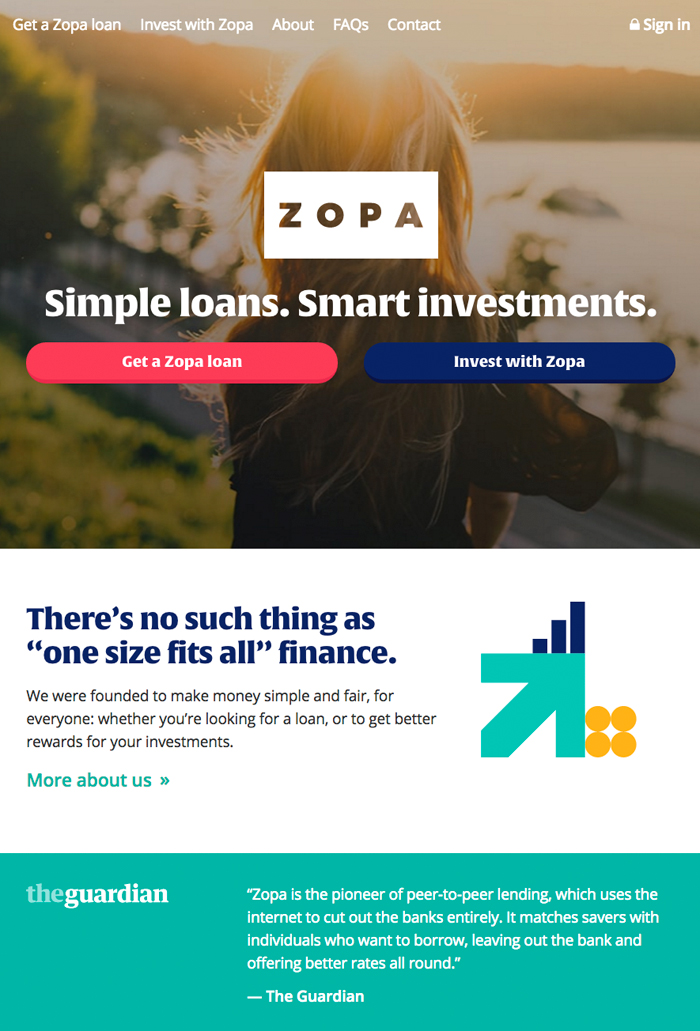
Image via Zopa
Zopa, a UK based company founded in 2004 and consisting of approximately 200 staff members, was the first peer to peer lending company, and provides clarity on what “brand refresh” entails:
Related: The Power of Disruptor Brands and Challenger Brands
Rebranding: 15 Do’s and Don’ts for Brand Success
/0 Comments/in Brand Relaunch, Brand Research, Brand Revitalisation, Brand Risk Management, Brand Strategy, Rebrand, Rebranding, Rebranding Mistakes, Revitalized Design /by Lorraine CarterSince 1903, the Pepsi-Cola (and later Pepsi) logo has seen many changes and facelifts in the form of rebranding and revitalisations. Through the last 100-plus years, the logo has evolved from what we might consider today an old-fashioned typeface through many fresh new looks.

Image via Pepsi
But while it’s interesting to follow the evolution of a well-known brand, let’s be perfectly clear. Changing a logo, altering the colour or even tweaking the name is not a rebranding strategy. Rebranding is much more than a design facelift. It may result in the design of new logos and the creation of new brand names, but it all starts as with your brand strategy first long before anything else relating to design is considered.
It’s essential to note that branding is NOT marketing or design but the bedrock foundation underpinning your whole business so getting your rebranding strategy right is critical to your success. In short, your rebranding strategy provides the direction for all your marketing, communications, positioning, language, messaging along with design.
And there are many strategic reasons to rebrand. A company may need to rebrand to:
- Re-establish its market prominence
- Acknowledge and reflect a major acquisition
- Announce a new technology or invention that changes its mission and vision
- Revitalize the voice and significance of the brand
- Refocus the company around major customer and/or industry trends
- Reflect a strategic move to reach new markets
- Give new life to flagging sales
- Move beyond a negative event
Whatever the reason, the key is to use your rebranding to help move your business and its products and services forward. Regardless of whether you’re rebranding a bank, hotel, power company or canned fruit, having the right strategy makes all the difference.
Want to discover more about rebranding to build your standout, №1 powerhouse, premium priced brand working with us so you can increase your profits and leave your competitors way behind?
- Schedule an appointment — we can meet in person or online
- Allow us to create a customised plan for you
- Let’s implement the plan together
- Contact us [email protected] or ring +353 1 8322724 (GMT Dublin/London time 9:00 – 17:30 weekdays)
One study of the hotel and hospitality industry in the United States attributes a 6.31% increase in occupancy to rebranding—and 60% of that to the power of the brand.[1] As researchers explain in their study, “Corporate Rebranding: An Integrative Review of Major Enablers and Barriers to the Rebranding Process”:
“Critical to successful corporate rebranding is the identification and application of six major enablers, including strong rebranding leadership and coordination among multiple functions and stakeholder groups.”[2]
To this end, we’ve compiled our list of 15 Do’s and Don’ts for Rebranding Success in order to help you navigate your next strategic rebranding and focus on critical leadership and coordination issues. We’ve been leading clients through all the various aspects of rebranding for more than twenty years so we want to ensure you engage in the process successfully by starting off on the right foot!
Also to help you achieve success, get our free download “Top 20 Rebranding Mistakes to Avoid.” here
We know that sometimes it’s a struggle to rebrand or revitalise your brand successfully yourselves so we’ve developed three different ways of working with us to help you rebrand successfully. So depending on your preferences:
- We can build your brand for you – find out more here or get in touch [email protected] or ring +353 1 8322724
- Empower you to build your brand – check out the Persona Brand Building Blueprint™ Mastermind here. This is a two-day intensive where you work on your brand with us codifying and mapping out your brand strategy for business growth. Alternatively, join our half-day Branding Accelerator Masterclass for a fast-injection of brand building essentials
- Want a DIY solution? Check out our ‘How to Audit Your Brand’ eprogramme here and How to Build a Brand eprogramme here
Top Rebranding Do’s and Don’ts
How important is your brand? The market research firm Millward Brown attributes more than 30% of the value of companies in the S&P 500 to the brand value.[3] Your brand is just as important, which is why you can’t cut corners during your rebranding.
1. DO challenge your reasons for rebranding
It’s not enough to “feel” that it’s time for a change. Whether you’re rebranding a product or the company, question the strategic advantage of your decision. What do you gain? Are there any other options or avenues open to you short of a complete rebrand? In other words, go into this with your wide eyes open and a clear sense of where you’re going and why.
When the Langham Hospitality Group decided to refocus its business to better serve a large middle-income population, it rebranded the business to focus on its new mission of service. In this discussion on Bloomberg, CEO Robert Warman clearly articulates their thinking:
2. DON’T focus your rebranding on simply redesigning your logos, changing colours and replacing fonts
There’s nothing wrong with giving your brand a facelift; just don’t confuse a design initiative with the objective of a true rebranding which is driven by a specific strategic intent. When you rebrand, you are communicating a fundamental change in the business.
In this video, UPS helps its SME / SMB customers understand the power of branding (and by extension rebranding). This is a strategic endeavor that extends to absolutely every aspect of your business…right down to a greeting and a handshake.
3. DO assess exactly what’s not working or what needs to change (and why) as well as what needs to remain the same by giving your brand a health check before rebranding
Just as you need to challenge your decision to rebrand (#1) you also need to dig deep into all aspects of your business to ensure you change/expand/update those things that need to be rebranded. And at the same time retain what’s still working and still reflects how you are doing business going forward.
If you need direction and support in giving your brand a health check feel free to get in touch [email protected] or give us a ring T: +353 1 8322724 (GMT hours). Alternatively, you can also give your brand a health check yourself to identify its strengths, weakness and areas for potential innovation and growth using our Auditing Analysis Accelerator™ programme. This is a step-by-step DIY walkthrough, complete with downloads, questionnaires and checklists, to help you audit your brand yourself. You can watch a section of the programme here.

Want to give your brand a health check. Use the Auditing Analysis Accelerator™ programme – get it here
Consider Malaysia Airlines. After the Flight 370 tragedy, you might think that their decision to rebrand would mean starting completely fresh—even changing the name. But as the new CEO Christoph Mueller tells CNN, there is so much loyalty to the brand that they feel that they need to keep the name.
4. DON’T use your competition as the focus of your rebranding
While it is essential that you know what your competition is doing and how you fit in among your key competitors, don’t let the competition drive your decisions. Do what is best for your business, what makes the most sense in terms of your products and services and what attracts your customers.
When you let the competition drive your business decisions, you’ll almost always end up playing a game of catch up or “me too.” To stand out, you need to be true to your vision, your culture, your philosophy and how it intersects with the values of your customers.
5. DO your homework on industry trends and your market before rebranding
While you need to know who your competition is and what they’re doing, your best insight is going to come from having a thorough up-to-date understanding of both industry trends and the wants and needs of the customers you are trying to reach.
This is doubly important if part of your rebranding strategy is to try to expand into a new industry or new marketplace. And your research should include talking with prospective customers in this new market. The more you know going into your rebranding effort, the better your position and your potential to succeed.
6. DON’T rebrand because it’s supposedly ‘cool’
Familiarity can breed boredom. And who’s more familiar with a brand than the people who deal with it every working day. Don’t fall into the trap of thinking that you need something fresh and new just because it’s been around for a while.
But here’s the good news: If you understand the strategic importance of your brand and how it stands for who, what and why you’re in business, you’ll be less apt to fall into this trap. Maybe you need to refresh your logo, change your packaging, advertising, update your brand collateral or bring something new to your social media approach. But these are more tactical changes—window dressing—and not a dramatic change in strategic direction.
7. DO involve all your employees in the rebranding discussion
When a business decision requires rebranding, it needs to be felt and carried out at all levels of the company. Everyone from the CEO to the newest hire has to be on board. But rather than hand down a new brand directive from the top, start your rebranding at the grassroots. Involve everyone in the process. Invite their input. Ensure that where management thinks it needs to take the brand is something that everyone can deliver on. Your employees will be more willing to do their part when they are empowered to participate in the process.
8. DON’T forget to interview your customers and get their perspective before rebranding
Just as you want to talk with prospective customers in any new markets you plan to reach, you don’t want to leave your current customers behind. Remember, it’s easier to retain customers than acquire new ones. So make sure that customers understand your decision to rebrand and feel comfortable that you’ll still be able to meet their wants and needs. And invite them to share their thoughts. They may have a perspective that you need to incorporate into your rebranding strategy.
9. DO work with experienced brand experts who can help guide you through the rebranding process successfully and ask the right questions along the way
There are so many moving parts to developing and executing a rebranding strategy that it pays to work with experts—people who live and breath the branding process. Not only can a branding consultant make your rebranding process easier, they can also help ensure that you don’t overlook some critical steps.
10. DON’T wait until after you change direction with your rebranding to think about the rollout
While it’s easy to get caught up in the details of the rebranding strategy itself, there are a lot of tactical steps to launching your rebranding—e.g., the event, a strategic location, how to employ social media. These are not afterthoughts. It’s not as simple as one day posting a new logo on your website, announcing an acquisition or creating the content and brand collateral needed to reach a new market.
You need your rebranding to launch without a hitch. So be sure to assign part of your marketing team to create the tactical plan that will help you relaunch your brand successfully.
11. DO manage your customers’ expectations with your rebranding
In addition to getting your existing customers’ perspectives on your brand and where you’re going in the future, you don’t want your rebrand to blindside your loyal customers.
If you have field reps, plan for them to speak with customers. Let them give their customers a head’s up as well as reassure them that their needs will be fully met going forward. If you rely on inside sales and don’t have a sales force, you might have a top executive call key customers or send out personal letters. You don’t want to lose the trust of the customers that have helped you build your business.
12. DON’T try to keep the old brand alive in any form with your rebranding
During your relaunch, you’ll announce that X is now Y. And once you’ve made the announcement, don’t try to make a slow or gradual transition. Dump the old logo, the old name, the old brand collateral…everything that represented who you WERE. Trying to phase out or use up old brochures or letterhead is confusing and actually defeats the purpose of the rebranding. The transformation must happen across all your brand touch-points consistently and congruently at the same time—not months apart! Move on with confidence, strength and clarity.
13. DO communicate your new strategy and tie it directly to the rebranding so everyone understands what you’re doing and why
Few things are more important than communication. The more people understand what you’re doing, why you’re doing it, how it will impact them and the timeline for everything you’re doing, the easier it is for them to support you and help ensure a smooth rebranding process.
After TriNet, an outsourcer of HR services acquired a large company, it quickly went through a rebranding. This brief video is a clip from a longer presentation showing how TriNet keeps its customer-facing employees informed and completely in the loop.
14. DON’T forget to register any new trademarks as part of your rebranding
Whether you’re changing the name of the company or adding new branded products, sub-brands or services, you’ll naturally check to make sure the names are available. Don’t forget to register and protect these names for your exclusive use in every country or market where you plan to do business. Without registering your brand names (and the relevant brand assets like your logo artwork) you may find yourself in a losing battle later to protect the brands you’ve worked hard to develop.
15. DO discuss the ownership of any copyrights on creative outputs as part of your rebranding
Finally, there’s the matter of creative ownership. When you hire a freelance artist or graphic designer or design agency you want to make sure that you have exclusive use of the intellectual property. While the law differs slightly from country to country, you’ll probably want to establish a “work for hire” arrangement. Talk with your attorney and your brand consultant on how best to proceed. Even if you don’t end up owning the creative outright, you can pay to lock up its exclusive use.
Rebranding Case Study #1: Putting Some New Kick in Old Spice
Although Old Spice has been creating personal grooming products for more than 70 years, the brand began to stagnate in the 1980s and didn’t improve even after Procter & Gamble bought the company. That changed, however, in 2010 with an extension to the product line and the funky rebranding in the guise of the Old Spice Guy. P&G didn’t simply reposition the product; it sold women on the idea of buying its new line of body washes for their men.
Old Spice is an often-told story of a great brand comeback through rebranding. Best of all, they didn’t make the mistake of losing the trust and following of loyal customers. If there’s one weakness in the Old Spice strategy, however, it may be that they’ve failed to stay one step ahead of other brands that have followed in their footsteps with equally off-beat videos.
Takeaway: With rebranding, you can bring new audiences to an old, established brand. But once you get the momentum going (or have the good fortune of going viral) you need to keep it going with marketing automation and strong data management techniques that allow you to interact with customers.
Rebranding Case Study #2: ABM Does More Than Windows!
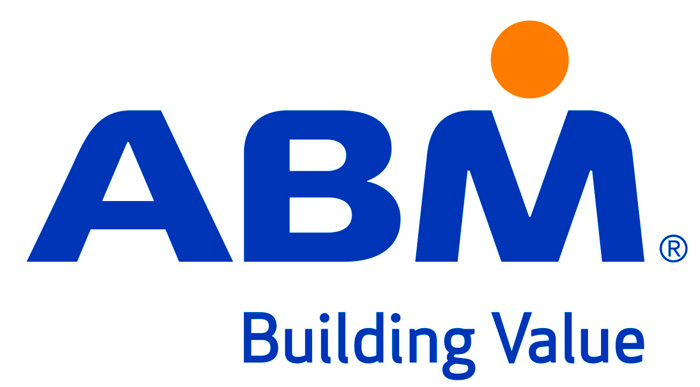
Image via ABM
Just three years after the 1906 earthquake, San Francisco was rebuilt and booming—enough so that Morris Rosenberg started up his window-washing business. In 1913, Rosenberg renamed his one-man operation American Building Maintenance Company and expanded into comprehensive janitorial services. Today the 100,000 employees of ABM Industries provide janitorial and facilities management around the world.
But ABM had a problem. While the company’s capabilities had expanded dramatically, most prospective customers still thought of it as a successful custodial service. ABM needed to build awareness for its expanded capabilities, including security and property systems engineering. It used the 2010 acquisition of the Linc Group to gain that awareness through a strategic rebranding that;
- Reorganized and simplified the range of service offerings
- Focused on the overall value ABM delivers through its integrated facility solutions
- Included a whole new brand identity
Takeaway: Rebranding your company can help you get the attention you need when you have a big message to deliver. In the case of ABM Industries, they capped off the whole process—new logo, reorganization of services, a new tagline—by ringing the NYSE closing bell in October 2012. ABM sent a message throughout the industry that this company is still growing and looking to the future.
Are You Ready for Rebranding?
If you think your company will benefit from a rebranding, ask yourself:
- Do we have a good reason for rebranding? If so, you need to be able to articulate it clearly.
- What are the strategic implications for our business? Is there any potential downside? Will this move leave any of our stakeholders behind?
- Have you presented the task to the entire company—from CEO to newest hire?
- Have you looked at your brand through your customers’ eyes and talked with them about your decision?
- Have you considered how you will bring your business plan into alignment with your brand going forward?
- Do you have a thorough plan for rolling out and implementing your rebranding? Do your employees understand the plan, know how it impacts them and have confidence they can live up to the objectives?
We know that sometimes it’s a struggle to rebrand or revitalise your brand successfully yourselves so we’ve developed three different ways of working with us to help you rebrand successfully. So depending on your preferences:
- We can build your brand for you – find out more here or get in touch [email protected] or ring +353 1 8322724
- Empower you to build your brand – check out the Persona Brand Building Blueprint™ Mastermind here. This is a two-day intensive where you work on your brand with us codifying and mapping out your brand strategy for business growth. Alternatively, join our half-day Branding Accelerator Masterclass for a fast-injection of brand building essentials
- Want a DIY solution? Check out our ‘How to Audit Your Brand’ eprogramme here and How to Build a Brand eprogramme here
Want to discover more about rebranding to build your standout, №1 powerhouse, premium priced brand working with us so you can increase your profits and leave your competitors way behind?
- Schedule an appointment — we can meet in person or online
- Allow us to create a customised plan for you
- Let’s implement the plan together
- Contact us [email protected] or ring +353 1 8322724 (GMT Dublin/London time 9:00 – 17:30 weekdays)
Your Client Satisfaction Guarantee
- When you work with us we’ll create a customised brand building plan and strategy with clear investment for you tailored to your specific requirements and preferences
- You’ll know each step of your brand building journey before we start because we’ll discuss it, document it and agree on it with you before work commences
- You’ll have timelines, key milestones and deliverables to evaluate and approve for each stage and part of your brand building process
- Because we know the unexpected sometimes happens we can make adjustments along the way if you need it and if something extra is requested we’ll ensure you’re fully appraised about what that entails before committing
- As we achieve pre-agreed objectives you’ll be able to evaluate your brand building work and strategy in progress, coupled with the outcomes to ensure return on investment
Get in touch today because we’d love to get started helping you build your standout, powerhouse brand so you can increase your profits and leave your competitors way behind. Email us [email protected] or ring us +35318322724 (GMT 9:00-17:30) and ask about our VIP Brand Strategy Discovery.

Image via Zillon Designs
[1] http://journals.ama.org/doi/abs/10.1509/jmr.13.0221?code=amma-site
[2] http://onlinelibrary.wiley.com/doi/10.1111/ijmr.12020/abstract
[3] http://www.economist.com/news/business/21614150-brands-are-most-valuable-assets-many-companies-possess-no-one-agrees-how-much-they
Brand Crisis – How to Manage, Survive and Thrive
/0 Comments/in Brand Audit, Brand Auditing, Brand Audits, Brand Crisis, Brand Failures, Brand Health Check, Brand Relaunch, Brand Reputation, Brand Revitalisation, Brand Risk Management, Brand Risk Mitigation, Brand Strategy, Brand Values, Branding, Customer Engagement, Entrepreneur, Rebranding, Situation Analysis /by Lorraine CarterThe one thing every brand product or service can count on is that there is a brand crisis in your future. No brand is immune. And, because bad news travels fast (faster than ever, due to social media), time is of the essence.
When do you have a brand crisis on your hands? Whenever there are “unexpected events that threaten a brand’s perceived ability to deliver expected benefits, thereby weakening brand equity.” [1]
It’s a Brand Crisis: First Things First
Step 1: Damage Control
Whether Mother Nature or manmade forces are at work, it’s critical that no matter how robust a brand you have built, you do have a “just-in-case” plan on the Public Relations shelf. A crisis management professional will guide you on the immediate essential steps and basic principles[2] of crisis management, and importantly, on your specific scenario.
From the very first moment that a sudden event, a mistake, or a piece of news impacts a brand negatively, savvy brand managers need to know:
- what to do first
- what never to say to the media
- how to prioritize
- what social media tactics are best
Step 2: Assessing the Brand Damage
According to the Financial Times, “When a brand crisis breaks out, consumers and other stakeholders (e.g., shareholders, the media, regulators) are likely to raise questions about the affected brand and why the crisis happened such as: who is to blame? Is the event likely to happen again? Is it true? What does the crisis signal about the brand?”[3]
When the frenzy begins to abate, your brand requires large amounts of tender loving care. The central question to be answered relates to the prognosis and timing for recovery. That is, brand owners and managers need to analyze both the short-term and long-term effects of the damage caused by the crisis for complete, cool-headed consideration.
Step 3: Short-Term Brand Damage
Assuming no loss of life or property, your short-term considerations are typically:
- sales
- consumer confidence
- an attack mounted by opportunist challenger brand(s).
Therefore, the task is to recover revenue, earn consumers’ trust, and deal with competitors in the right way.
A silver lining comes from gaining positive lessons learned from a negative experience…it’s never more important than when one’s “dirty laundry” has been on display for all to observe.
Nevertheless, a brand audit followed by a refresh or re-branding may very well be in order at this critical moment.
After the Brand Crisis: Getting Back to Normal
Step 4: Long-Term Brand Damage
A crisis is a harsh teacher and requires cool heads to respond rationally to an irrational situation. Ultimately, every crisis has a resolution.
How a brand deals with a crisis during the short-term damage control step will have a lasting effect on its reputation in the long-term, where it matters most. Indeed, that behaviour becomes a benchmark for the brand as conversations in the public sphere revolve around the brand’s handling of the event.
Because every situation is different, it’s impossible to say how long after the initial crisis occurs that step 4 will begin. It could be days, weeks, or months. Experts agree, “The scale and duration of this impact depends on a number of factors, including a brand’s track record and established consumer goodwill, as well as how quickly brand custodians respond to the crisis.” [4]
If you need to evaluate your brand’s vulnerabilities, weak points and areas in need of change then now is the time to use the Auditing Analysis Accelerator™. It’s an online programme that walks you through, step-by-step, the process of giving your brand an audit. A critical management tool in every brand owners arsenal.
Step 5: The Problem Gets Fixed
In a widely shared 2005 op-ed published by the Wall Street Journal[5] following the devastating Hurricane Katrina, the former chairman of General Electric presented his thought leadership memo about the five stages of a crisis. According to Jack Welch, the fifth and final stage in crisis management is when the problem gets fixed.
A benefit derived from a crisis is that it lets us know where things are broken and can help us to identify solutions so that future similar crises may be avoided. But this benefit applies only if we take the appropriate steps to learn those lessons and to apply that wisdom to our brand.

It’s mandatory to undertake the post-crisis approach strategically. In the words of Jawaharlal Nehru, statesman of India, “Every little thing counts in a crisis.”
What Now For My Brand?
As a branding expert, Persona Design can provide insights and advice about getting your brand back to ship-shape by determining:
- Whether the original brand strategy needs adjustment
- How to create a new brand promise
- To what extent the brand can recover
- Whether a brand refresh is appropriate
- Does the brand need repositioning?
- Whether a re-branding is required
- What a re-branding should look like
This process begins with a detailed brand audit focused on recovery. This procedure determines your brand’s market position versus competitors, identifies where brand strengths and weaknesses lie, reveals inconsistencies and opportunities for improvement, and flags new developments.
Option 1: A Brand Refresh
In the wake of a crisis, a refreshed brand must create and clearly communicate new company values.
Option 2: A Re-branding
A brand audit will determine whether the brand can survive. Some brands, including large ones like Arthur Andersen (now Accenture), cannot survive a deep crisis.
Calculated and deliberate brand re-building to repair brand reputation is not a frivolous process. It requires a serious and thoughtful strategy based on customer perception, behaviour and values.
Let’s look at five types of crises that commonly occur in a small-to-mid-sized company and use illustrations found within larger corporations. Note that the strength of a brand image will mitigate damage in crisis aftermath, with smaller brands being more vulnerable than these household names.
A Bump in the Road for Brands
1. Product Failures
As a small-to-medium retailer, you can be caught up in a failed product originating with one of your suppliers. It’s a costly headache for retail management having to refund customers’ money, give them replacements, deal with the supplier, while hoping the problem doesn’t get any worse or rub off on your own brand. When a product failure occurs, you may benefit from professional brand reputation management.
Example: Due to six fatal incidents, millions of unstable dresser units have been recalled by IKEA[6], which is responsible for their own supply chain as manufacturer and reseller. This product recall is one of 17 for IKEA in 2015 through mid-2016.[7]

IKEA Malm dressers (IKEA Corporate News website)
Result: Surveys indicates that the world’s largest furniture retailer’s reputation is hit hard, but the brand will survive, according to experts like Stephan Shakespeare, founder and CEO of YouGov, who writes in July 2016, “The good news is that IKEA’s overall Value Score remains relatively untroubled – in the UK at least. While this remains the case, IKEA can be assured its offering will continue to be popular…IKEA should be thankful that it has such a strong brand image, and indeed one that people around the world have a connection and loyalty to.”[8]
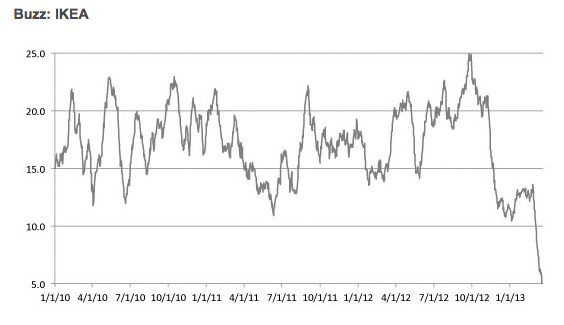
Image via Buzz Score (YouGov)
2. Brand Embarrassment
Keep your clearly defined brand values front and centre in the mind of the customer. If something embarrassing does occur, seek advice from a professional branding agency to prevent customers from expressing dismay with their feet and their wallets.
“People buy a brand because it says something about who they are and what they believe in,” according to Deborah MacInnis, PhD, a professor of marketing at the University of Southern California Marshall School of Business. “If there’s a brand that does something bad, people feel betrayed but also feel that wearing it would signal that they agree with the values of the company.”[9]
Example: High priced teen apparel brand Abercrombie & Fitch lost its status as darling of the Millennials when the CEO made disparaging comments about customers who didn’t fit the store’s skinny sizing. An employee with an eating disorder gained 68,000 petition signatures and an apology.
Result: Sales have been impacted to the degree that store closings are the only option. The brand continues to close sizeable chunks of its portfolio of (previously) 946 U.S. store locations.
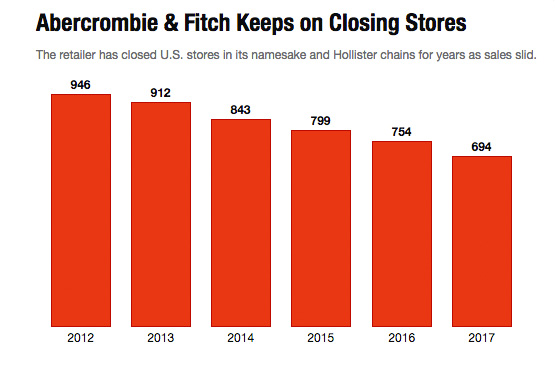
Image via Fortune, source Abercrombie & Fitch filings
3. High Profile Dishonesty
Just one untruthful comment by one top executive can negatively affect a brand. This can be particularly disruptive for service brands where the emphasis is on people. A renewed brand promise will help get things back on track.
A Canadian-based digital strategy specialist writes, “Brands aren’t heartless, mindless, soulless, brick and mortar stores. They are built by people. And no customer wants to associate with brands that comprise of unscrupulous, unreliable people. Honesty is always number one on buyers’ desirability index.”[10]
Example: After a 22-year career, NBC’s former national news anchor, Brian Williams, lost his job after exaggerating a report about his experience on the front lines in Iraq.
Result: With a quick response from NBC, a Williams apology, and a seven-month suspension for its news anchor, the network weathered the storm around trustworthiness. The popular news announcer who had enjoyed a 10-year, $15 million/year contract was brought back on air, albeit with a demotion to the network’s related cable brand, MSNBC.[11]
4. Broken Brand Promises
In the consumer’s mind, Whole Food stands for healthy eating, responsibly grown, and high quality standards, so that shoppers can buy with confidence around issues they care about.[12] A series of giant consumer let downs have occurred. Whole Foods Market, Inc. is big enough to fund their own newly hired full-time professional global VP to handle post-crisis brand strategy.[13]
Example: Whole Foods dropped the ball on their own brand promise. Last year, Whole Foods was found guilty of price mischarging from California to New York. In another salvo at Whole Foods in June 2016, the U.S. Food & Drug Administration issued a series of safety standard warnings[14] regarding fundamental cleanliness standards.
Result: Consumers were unimpressed when Whole Foods responded with a video from the company’s CEOs. People reportedly found the performance insincere, punctuated with the kind of overt gesticulation that students of body language are trained to spot. No discount was offered to entice customers back. Share prices for Whole Foods Market, Inc. have depreciated 25 percent in 12 months[15] and they’re pivoting to an ancillary brand, a smaller store with less selection, called 365, aimed at Millennials.[16]
What happened to “The Customer is Always Right”? Harry Gordon Selfridge may have overdone customer service with that mantra back in 1909. However, when a business’s explanation is open to interpretation as “we’re sorry we got caught,” you can be sure that savvy consumers aren’t buying it.
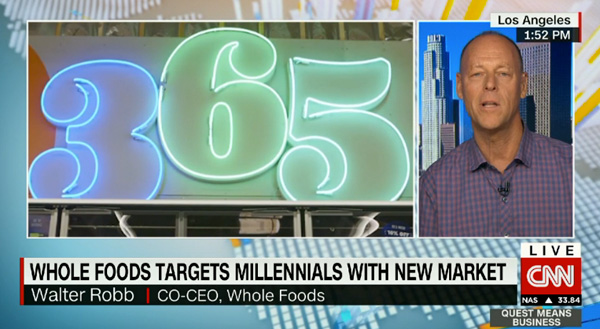
Image via YouTube
5. Scandals
When internal and external brand values are out of alignment and don’t match, the result can be devastating. FIFA, Volkswagen, Sports Direct, Chipotle, Bill Cosby, Ryan Lochte. And now Wells Fargo, one of the world’s largest banks (with a comfy Old West stagecoach brand image) was fined $185 million and released 5,300 when a fabricated bank account scandal broke.
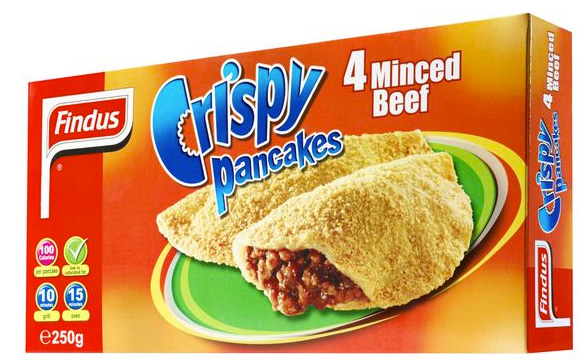
Image via Mirror UK
Example: For Findus, 50 years in the UK grocer’s frozen food aisles, it was one scandal too many. Following the uproar of 2013, when the beef lasagne was found to contain 60 to 100 percent horse meat, the product was pulled and the brand was sold. Time did not heal, as it became known that the brand had been served in 2,300 schools, hospitals, prisons, armed forces and senior housing,
Result: From spring 2017, the Findus brand is no more.[17]
Are you struggling with how to reposition your brand, rebuild your brand values, improve your brand promise — make your brand standout for the right reasons so it’s memorable and distinctive in ways that make it much loved? Then the Personality Profile Performer™ online programme is a perfect fit for you. Enroll today and make your brand highly visible and loved.
Questions to ask while reinforcing or rebuilding your brand:
• How strong is your brand reputation?
• What problem does your brand solve for its customers?
• Are your brand values clearly defined and communicated?
• How does your brand deliver on its promise?
• How do your employees, partners, vendors, suppliers and owners view your brand?
• When was the last time you conducted a brand audit?
[1] http://blog.ebiquity.com/2015/07/why-it-pays-to-take-the-drama-out-of-a-crisis
[2] Bendel, Peggy. “It’s a Crisis! Now What?” SutherlandHousePublishing.com, 2012.
[3] http://lexicon.ft.com/Term?term=brand-crisis
[4] http://blog.ebiquity.com/2015/07/why-it-pays-to-take-the-drama-out-of-a-crisis
[5] http://www.wsj.com/articles/SB112666533279540108
[6] http://www.ikea.com/us/en/about_ikea/newsitem/062816-recall-chest-and-dressers
[7] http://www.ikea.com/us/en/about_ikea/newsroom/product_recalls
[8] https://yougov.co.uk/news/2016/07/06/ikeas-drawer-debacle-wont-destroy-uk-image/
[9] https://mic.com/articles/130147/researchers-are-now-able-to-measure-just-how-embarrassing-an-uncool-brand-is#.T70A15Xkv
[10] http://www.business2community.com/branding/4-reasons-dishonesty-can-kill-brand-faster-bad-strategy-01084600#5XME1zbb2yep2m34.97
[11] https://www.washingtonpost.com/lifestyle/style/at-long-last-brian-williams-is-back–humbled-and-demoted-to-low-rated-msnbc/2015/09/21/ea423408-6077-11e5-b38e-06883aacba64_story.html
[12] http://www.wholefoodsmarket.com/mission-values
[13] http://www.vanityfair.com/news/2016/09/brooke-buchanan-theranos-whole-foods
[14] http://www.fda.gov/ICECI/EnforcementActions/WarningLetters/2016/ucm506089.htm
[15] http://www.investopedia.com/articles/markets/062016/what-whole-foods-latest-woes-mean-stock-wfm.asp
[16] http://money.cnn.com/2016/07/27/investing/whole-foods-earnings-july
[17] http://metro.co.uk/2016/01/31/goodbye-findus-crispy-pancakes-brand-dogged-by-horsemeat-scandal-is-to-disappear-5654449/
10 Branding Tips From Silicon Valley on How to Be a Successful Startup Brand
/2 Comments/in Brand Positioning, Brand Profiling & Positioning, Brand Promise, Brand Relaunch, Brand Revitalisation, Brand Story, Brand Strategy, Brand Values, Brand Voice, Branding, Entrepreneur, Rebrand, Rebranding /by Lorraine CarterFrom Silicon Valley to Silicon Docks and Silicon Roundabout, the buzzwords “entrepreneur”, “branding” and “startup” get bandied about quite a bit, so let’s take a look at their meanings. Dictionary definitions indicate that an entrepreneur is a person who initiates, organizes and manages a business and assumes its risk. A startup is the vehicle for doing so and branding is what makes your brand highly visible, different, memorable and much loved. Underlying the definition in common use today, is that an entrepreneur has a vision for a new brand, a startup that will disrupt a particular practice.
Entrepreneurship is “creative, disruptive innovation,” as notably coined by the early 20th century economist Joseph Schumpeter.
A century later, a newer definition, courtesy of Silicon Valley-based investor Reid Hoffman[1], is: “An entrepreneur is a person who jumps off a cliff and builds a plane on the way down.”
 Image via Gapingvoid, © Hugh MacLeod
Image via Gapingvoid, © Hugh MacLeod
Branding From the Beginning
Startup brands in our commercial midst are actually nothing new. In fact, branding has been central to the success of innovators from the beginning. For centuries before modern society’s computer chip lent Silicon Valley its moniker, startups have been an essential part of the economy, picking up steam — to coin a phrase — during the Industrial Revolution. In the Information Age, entrepreneurship accounted for 14 percent of all working-age Americans in 2015, some 27 million people, in the USA alone. [2]
Startup Brands Are Still Brands
Startup brands are brands, just like established ones, only less developed. And, a branding professional who has been down this road many times can provide all-important markers for you in trailblazing the way ahead for your new brand. You’ll want to avoid brand mistakes that will likely require a costly do-over in time. Our Personality Profile Performer™ Programme is designed to guide brand owners and managers to build a highly visible, different, memorable and much loved new brand from scratch.
From birth you need a memorable name, a mission statement, a brand promise, a standout brand personality and a strong brand strategy prior to a brand launch. No one will debate that creating a startup brand isn’t hard work. We’re here to help!
Whether it’s the first sewing machine, a craft beer, or a new messaging app, being a founder is all-consuming…and always starts small even when you are thinking big.
What Is and Is Not Your Brand
The adage, “Everything is your brand and your brand is everything,”[3] as it appears in the pages of the Harvard Business Review, is true enough. However, until and unless you have your brand’s core values and the building blocks of your brand foundation in place, it is premature to take the next steps.
Your logo is not your brand. Your clever new dot.com name is not your brand. Your website is not your brand. Your packaging is not your brand. These are components of your brand to reflect your purpose and value.
Also, your place of business is definitely not your brand. Even a billion dollar brand can start in somebody’s garage…and they certainly have:
- Disney in 1923
- Hewlett Packard in 1939
- Apple in 1976
- Amazon in 1994
- Google in 1998
Essentials for Startup Brands and Branding
As an entrepreneur, YOU are the voice and visionary of your brand, you embody your brand and your passion shows. Seasoned Silicon Valley startup pros offer plenty of free advice for today’s entrepreneurs.
One of the key takeaways on perspective comes from Dave McClure[4], the straight-talking co-founder of 500Startups, a Silicon Valley startup accelerator and global investor. Here, McClure is describing the best way to make an elevator pitch for funding — yet the essence of his advice is spot-on for the strategic approach to building the foundation of a startup brand. He counsels:
“Here’s the secret: Pitch the problem, not the solution.”
“Just tell me the problem FIRST, not the SOLUTION. The reason is, I may not be able to understand what your solution does, but if you connect emotionally with me on what the problem is — and hopefully I also have the problem, or know someone who does — then I’ll give you PERMISSION to tell me more about how you’re going to solve the problem.” |
Ten Essential Startup Branding Tips
Here we take a look at 10 essential startup branding tips with comments from a dozen or so outstanding innovators and advisors from the Silicon Valley dot.com frontier.
- Amazon founder Jeff Bezos
- Lynda co-founder Lynda Weinman
- Linkedin co-founder Reid Hoffman
- Microsoft founder Bill Gates
- YouTube CEO Susan Wojcicki
- Apple founder Steve Jobs
- Media personality Oprah Winfrey
- Intuit co-founder Scott D. Cook
- Venture capitalist Matt Turck
- High tech investor Ben Horowitz
- Hewlett Packard CEO Meg Whitman
- Facebook founder Mark Zuckerberg
- Facebook COO Sheryl Sandberg
- SpaceX and Tesla founder Elon Musk
- Winner of Ireland’s Best Young Entrepreneur 2015 and “Best Start-up Award” at Google’s Dublin HQ, 24-year-old James Foody, now San Francisco-based
Tip #1: Building Your Brand
“You don’t know what you don’t know.” – Oprah Winfrey at a 2014 Stanford University Graduate School of Business interview.[5] |
Don’t try this alone. Silicon Valley wisdom counsels that even a genius cannot create a successful startup brand alone. No single person can possess all the required skills and have all the tools in their shed. Consider co-founders and advisors to move your business and branding strategy forward in the right direction. Remember…the “Fifth Beatle” for the Fab Four was their manager.
“My model for business is The Beatles. They were four guys who kept each other’s kind of negative tendencies in check. They balanced each other, and the total was greater than the sum of the parts. That’s how I see business: Great things in business are never done by one person, they’re done by a team of people.” – Steve Jobs |
TechCrunch, a San Francisco, Silicon Valley media platform, says mentors are the secret weapons for a successful startup brand.[6] Their study shows that “mentors who had already achieved success in the tech industry were able to help younger tech startups outperform their peers by a factor of three.”
Broadlake, in Dublin, models their whole philosophy on a very hands-on approach as both advisors, mentors and investors who invest their time and capital to help entrepreneurs succeed.
“There’s always new challenges and I think with new challenges we gotta switch on, we gotta engage, we gotta work with these teams and try and achieve often for what these ambitious growing companies are looking to do, which is ground breaking stuff.” – Pete Smyth, Broadlake |

Image via Broadlake
“Everyone needs a coach. It doesn’t matter whether you’re a basketball player, a tennis player, a gymnast, or a bridge player.” – Bill Gates |

Image via Stanford University
Tip #2: A Brand is Not a Logo
Brands are not solely visual. Your new brand is about how you make people think and feel about your product or service. The most common misperception out there among startups is from those who think their brand is about their logo and not much else! CEOs, owners, partners, investors and founders should not make this mistake…nor should designers.
“Your brand is what people say about you when you’re not in the room.” – Jeff Bezos |

Image via Slideshare
A side note: When Marissa Mayer was appointed new CEO of a struggling Yahoo in 2013, a new logo was among the first tasks undertaken by an internal committee. Meantime, email customers were unhappy with their service.
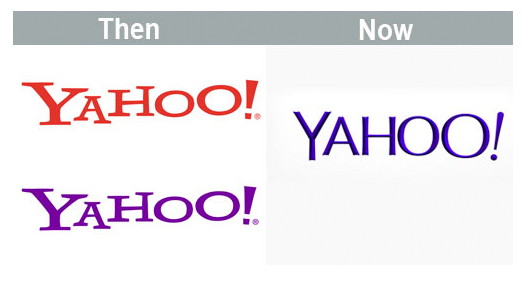
Image via Naldz Graphics
Lesson: When Yahoo skipped the brand audit they ended up with a deep customer disconnect that was never regained. [7]
The Yahoo backstory to date:

Image via Twitter
Tip #3: Build Brand Trust
As a founder, you are the embodiment of your brand both internally and externally. From the moment you interact with your first core users, trust is critical. Your company may grow, but brand trust is a constant.
“Google is a consumer company and our success is directly linked to our users trusting us.” – Susan Wojcicki |
And when you hire, make sure you hire the right people to personify the brand in its infancy. It is absolutely critical that your brand is represented properly all the time.

Image via Twitter
“If someone likes you they will listen to you. If someone trusts you they will do business with you.” – James Foody, Ayda |
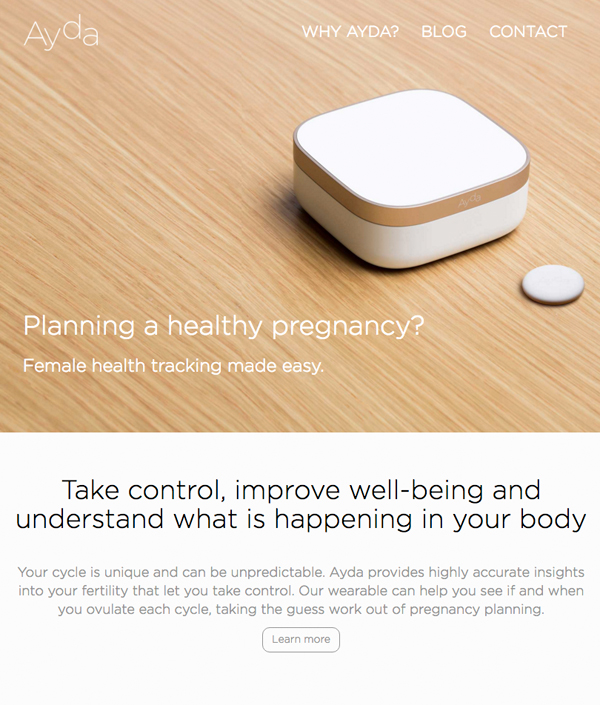
Image via Ayda
Tip #4: Identify Brand Need
When Lynda Weinman started teaching web design in 1993, she went in search of a textbook. All the books she found were too technical for beginners. (You can probably see where this story will lead.)
“I remember thinking maybe this book doesn’t exist yet. I went home from the bookstore and wrote the book proposal.” – Lynda Weinman |
It was early days on the internet in 1995 when Lynda then got the idea to move her reference materials online and create a teaching course around them. Two decades later, Weinman had earned the nickname, “Mother of the Internet.”[8]
In the spring of 2015, Lynda Weinman sold her company, Lynda.com, to LinkedIn for $1.5 billion. The new owner, the world’s premier business-oriented social networking service, was seven years away from its own founding when the brand Lynda.com was created.
Tip #5: Become a Brand Guru
Once you’ve identified a passion, become an expert in whatever it is. Tell your story well. In the brand’s early days, you need anecdotes, not raw data. Be authentic, be enthusiastic, be clued up and know your stuff. Your brand promise must be frequently voiced, relatable, and completely transparent.
“Whether you are interacting with customers, fundraising or recruiting, you are always selling and, and the best salespeople are master storytellers. Craft a compelling and genuine company story that resonates with your audience not just intellectually, but also emotionally.” – Matt Turck, Venture Capitalist, FirstMark Capital |
Tip #6: Determine Brand Positioning
“A brand is no longer what we tell the consumer it is — it is what consumers tell each other it is.” – Scott D. Cook |
Your core customers are your sounding board — an important audience for a startup. Is your brand positioning clear? Customers want companies to listen to their opinions, so you’ll need feedback to guide you in shaping your brand position in the marketplace. Before you can concern yourself with traction and loyalty, you need to ensure that the brand resonates, fills a need, and has value. Get feedback at every iteration along the way to ensure you’re moving in the right direction for consumer wants and needs. Tweaks will be necessary.
“Another one of my favourite posters at Facebook declares in big red letters, “Done is better than perfect.” I have tried to embrace this motto and let go of unattainable standards. Aiming for perfection causes frustration at best and paralysis at worst.” – Sheryl Sandberg |
Tip #7: Communicate Your Brand
It can be difficult to properly communicate your startup vision to others. But, it’s critical that you do so effectively.
Keep lines of communication open constantly and force yourself to listen to critics. Learning how to manage people takes work. But if you don’t learn how to communicate, you risk destroying relationships with customers and employees.
“As a company grows, communication becomes its biggest challenge.” – Ben Horowitz |
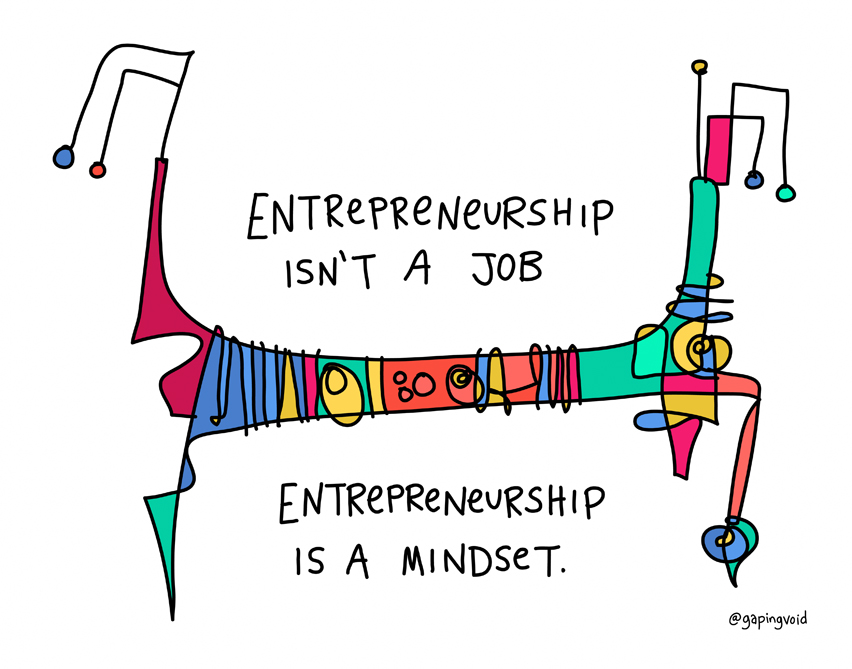
Image via Gapingvoid, © Hugh MacLeod
Tip #8: Delight Your Customers
Bill Gates says the one word that best describes the startup mindset is optimism. Self-made multi-billionaire Warren Buffett says “At 85, I tap dance to work every day.”
Have fun and the pleasure of doing business with you will show right across your startup brand. Even if your brand is about heavily scientific based inter-planetary colonization, like SpaceX founder Elon Musk, let your good humour shine through.
“I would like to die on Mars, just not on impact.” – Elon Musk |
“Fun is at the core of the way I like to do business and it has been key to everything I’ve done from the outset. More than any other element, fun is the secret of Virgin’s success.” – Richard Branson |
Tip #9: Believe in Your Brand
Perseverance is the name of the game. Believe in your vision. Remember the lesson from a 30-year-old Steve Jobs when he got fired from the company he founded…it’s OK to fail. So be brave, take risks, learn from them, and don’t give up if you love what you do.
Passion will keep you going when you get hit in the head with a brick, which will only make success taste even sweeter.
Fact: A startup brand will experience setbacks.
“See criticism as free learning that makes you a better entrepreneur. Don’t be constrained or deflated by criticism, but do learn from it.” – James Foody |
Tip #10: Nurture Your Brand
Once you’re certain your startup brand is is ready for launch, keep your vision focused on the moonshot…the thing that people may not think is possible could be within your reach. Listen to your inner GPS and let it guide you on the ride of your life.
“Picking what problem to go and solve is a much bigger and more important challenge than being able to solve the problem.” – Mark Zuckerberg |
“When people use your brand name as a verb, that is remarkable.” – Meg Whitman |
Ask Yourself…
- Are you developing a new brand to launch to market but you’re just not sure where to start to ensure a strong financial return? Our “Personality Profile Performer”™ course is perfect for you.
- Have you got an existing brand but it’s just not strong enough to make it to No.1 in the market? Talk to us about how we can guide you to build your brand recognition plan.
- Have you underestimated how difficult a startup brand really is? Or, perhaps you’re not dreaming big enough. We can help you with a branding strategy to ensure that you are properly positioned.
- Are you struggling with your brand story? Let us help you craft a compelling one in your brand’s own tone of voice.
- Does your brand identity need a boost? We can consult with you on everything from font to packaging design.
- Have you attempted a startup that missed its mark? We can help you revitalize and relaunch a product or service to get the result you’re looking for.
[1] https://www.linkedin.com/today/author/1213
[2] http://www.inc.com/leigh-buchanan/us-entrepreneurship-reaches-record-highs.html
[3] https://hbr.org/2011/06/a-logo-is-not-a-brand/
[4] https://www.linkedin.com/in/davemcclure
[5] https://www.youtube.com/watch?v=6DlrqeWrczs
[6] https://techcrunch.com/2015/03/22/mentors-are-the-secret-weapons-of-successful-startups
[7] http://www.inc.com/cody-steve/yahoo-logo-redesign-marissa-mayer.html
[8] http://bit.ly/2aj9GDW
Eleven Branding Lessons: Keeping a Sharp Eye on Your No.1 Asset
/0 Comments/in Brand Audit, Brand Auditing, Brand Audits, Brand Collateral, Brand Health Check, Brand Name Creation, Brand Name Origination, Brand Personality, Brand Relaunch, Brand Relevance, Brand Reputation, Brand Research, Brand Risk Management, Brand Risk Mitigation, Brand Strategy, Branding, Customer Engagement, Rebranding Mistakes, Situation Analysis /by Lorraine CarterOnce the heavy lifting in creating your brand is done, basic care and ongoing maintenance to preserve and protect it must not be overlooked. “Nurture your brand as you would a child,” says brand expert Jagdeep Kapoor, author of the bestselling “Twenty-Four Brand Mantras.” Just like all living things, a brand requires nurturing to remain healthy and to grow.
From creation through to end-of-life, a brand can encounter unexpected challenges arising from all sorts of corners, not just from the competition. From a poorly planned campaign to a corporate takeover, and from an outspoken CEO to a badly chosen name, a few examples that made recent headline news are worth a closer look to form takeaways and lessons learned for brand owners and managers everywhere.
Case Study: Rhode Island Is Not Iceland – Tourism Campaign Has Too Many Mistakes, Says Governor
America’s smallest state ought to know that details matter. When Rhode Island set out to create its new $5 million integrated tourism and new business promotion campaign, big guns were brought in. Who better, you might think, than Milton Glaser, the graphic designer who created the iconic I ❤ NY campaign?
Lesson #1: Politics matter! Milton Glaser and Havas PR North America, chosen for the PR contract, are New York City firms, not Rhode Island firms.

The newly launched campaign featuring a slogan “Cooler & Warmer” left many people cold…and guessing. What does it mean, they queried across social media channels. One Commerce Corporation board member said he saw “no emotional connection” and “no personal brand to the state or the people.”[1]

An ATOM Media executive in Providence, RI said, “Usually a slogan is something that people know instantly and understand. I think the fact that you need to explain it could be a little problematic.”[2] That sentiment was echoed by the owner of a Newport, RI marketing and graphic design agency, who said the slogan, “Doesn’t make any sense to me. In order to create a good tagline you have to have a brand strategy.”[3]
Lesson #2: Brand strategy comes before name, tagline and logo creation.
Lesson #3: Graphics must reflect and express a brand’s persona, and that must be one that resonates with people, not one that needs to be explained.
Lesson #4: Social media matters! A tagline containing a special character or symbol (such as the ampersand in Cooler & Warmer) won’t function as a hashtag[4]. Ever.
That wasn’t all. A YouTube video released with great fanfare was yanked within 24 hours when it was pointed out, “Hey, that’s not Rhode Island — that’s the Harpa concert hall and conference center in Reykjavik. Iceland.”[5] Other footage featured a highly acclaimed restaurateur who had already moved his operation to Boston. And the video also claimed 20 percent of America’s historic sites are in the little Ocean State, when it’s actually 2 percent.[6]
This was the ‘alternative’ Rhode Island Cooler & Warmer ‘spoof’ version produced by The Wonderful Show!
Lesson #5: Accuracy matters! The state’s marketing director resigned. Media partners are returning their contract fees to the taxpayers. Cooler & Warmer was scrapped.
After an initial attempt — picked up internationally, even by The China Post[7] — Governor Raimondo took a different tack at a news conference, saying, “One of the things I’ve learned from listening and engaging with people is that there should’ve been more public participation in this thing from the get-go.”[8]
With that in mind, Newport Buzz posted a public contest, pitting “Cooler & Warmer” against the previous slogan, “Discover Beautiful Rhode Island,” and a local amateur entry, “Sea to Believe.” With 15,000 votes in so far, the local resident’s idea is clear away the favorite with 80 percent, versus the traditional one at 18 percent and the costly new-fangled entry coming in dead last at 2 percent.
Lesson #6: There’s no room for ivory tower decision-making. Consultation is critical, brand audits are essential.
More Takeaways: All brands should consider geographical location of their contractors and supply chains when performing due diligence in order to avoid potential embarrassment. The look and feel of the brand via tagline, logo, adverts, all brand collateral, media and all touchpoints must resonate with its audience, make an emotional connection and be authentic. The importance of fact-checking and the need to eliminate exaggerated claims cannot be overstated. Handle a brand crisis with carefully thought-out strategy, not something to poke fun at.
Case Study: Brand Takeover – Richard Branson Reacts to Virgin America Sale
Sir Richard Branson is himself a brand who runs a brand that has sub-brands. The self-made billionaire wasted no time addressing the Alaska Airlines purchase of Virgin America — just in case of any tarnish rubbing off on the overall Virgin brand name.

Image via www.virgin.com and Virgin America
Well aware of the fierce loyalty of Virgin America fans for what they consider a superior product at parity prices, Branson let everybody know, “I would be lying if I didn’t admit sadness that our wonderful airline is merging with another. Because I’m not American, the US Department of Transportation stipulated I take some of my shares in Virgin America as non-voting shares, reducing my influence over any takeover. So there was sadly nothing I could do to stop it.”[9]
Lesson #7: Confront a brand crisis. Deal with it, manage it, communicate about it professionally and do not hide from it.
In a statement that’s a pleasure to read in its entirety, due to the passion readers can sense, Branson goes on to discuss the importance of the brand, “…once Alaska witnesses first-hand the power of the brand and the love of Virgin America customers for our product and guest experience, they too will be converts and the US traveling public will continue to benefit…”
Even in the face of a forced merger, the rest of the Virgin brand received immediate reinforcement from the top. “Our Virgin airline has much more to do, more places to go, and more friends to make along the way,” Branson stated.
Lesson #8: Find the silver lining. Notice how Branson uses this corporate takeover event as an opportunity to reiterate the ongoing benefits of a Virgin travel experience.
Case Study: Tarnished Brand – Trump Empire?
In his run on the US presidency, Donald Trump’s raucous attention-grabbing style and statements is affecting custom at Trump Collection branded apartment towers, hotels, resorts and golf courses.

Image via http://www.npr.org
Polling and consulting firm Penn Schoen Berland survey results found that 45 percent of respondent US residents with annual earnings of $200,000 or more will make a point of not visiting a Trump hotel or golf course over the next four years. Within that group, 77 percent indicated they would actually boycott the Trump brand.[10]
Lesson #9: From the CEO to front line employees to the back of the house operation, your brand is represented by everyone in each and every customer (and potential customer) interaction. Everyone is, or should be, an ambassador for your brand.
Case Study: Stay Relevant, For The Times They Are A-Changin’
In the 1980’s, four-time Olympic diving gold medalist and five-time world champion Greg Louganis was passed over for one additional honor — an appearance on the Breakfast of Champions Wheaties Legends cereal boxes. Louganis is openly gay, HIV-positive and an LGBT activist. He is also “widely viewed as the greatest diver in the history of the sport,”[11] according to a recent communication from the Wheaties maker, General Mills.
Calling it “a ground swell of love,” Louganis told Hollywood Today that a petition signed by 40,000-plus people brought the oversight to the attention of General Mills. At age 56, Louganis joins a highly decorated Olympian swimmer and hurdler, a woman and a black man, in the brand’s revamped Wheaties Legends series packaging, available on the grocery store shelves (one million boxes!) from May 2016.

Image via http://www.blog.generalmills.com
Lesson #10: A brand needs to stay relevant to stay alive. The brand must respond to feedback and act to correct an out-and-out mistake.
Case Study: What’s In a Name – Law School Learns to Study Harder
Experts highly recommend that even the smallest of brands invest time and effort in getting a name right from the start to avoid potential legal issues and massive upheaval if a change is required. That advice takes into consideration everything from spelling to acronyms to trademark and domain name. Later, a brand might tweak a logo, revamp packaging design, shift media channels, or even undertake a rebrand if necessary.
AdWeek reports that a recent study by U.K. research firm MillwardBrown found “many brands that change their names can expect an immediate 5 to 20 percent drop in sales, and that the new brand image ‘may not be as strong as it was before.’”[12]
After U.S. Supreme Court Justice Antonin Scalia passed away in February, George Mason University outside Washington D.C. renamed their law school after Scalia upon receiving a $30 million gift to do so.

Several tweets later[13], the school realized the awkward acronym they’d created and made a swift change away from Antonin Scalia School of Law, or ASSOL.[14] A crisis was averted at Antonin Scalia Law School before any signs went up or ribbons were cut.
-600px.jpg)
Image via https://www2.gmu.edu
Spelling Counts: When Small Brands Make Big Mistakes
Branding experts point out that misspellings, bad foreign language translations and tricky signage is an area frequently causing trouble at small companies which attempt an in-house branding effort. Even big brands don’t always get it right, with sometimes alarming results.[15]
Amusing examples can occur when random neon lights fail and the Essex House becomes Sex House and Dynasty Restaurant becomes Nasty Restaurant.

Image via Reddit
Even an airport parking garage can be considered part of the airport’s brand. Here’s a curious example of why details matter, right down to vetting your contractors and proofing the signage.

Image via Reddit
Lesson #11: Seek professional assistance in naming a brand to avoid potentially disastrous errors and oversights.
Questions to consider:
• Would you agree that branding is even more important and valuable for small businesses than it is for big companies?
• Have you fully addressed your brand profiling, positioning and brand strategy prior to jumping into logo design or tagline development?
• Have you considered consumer research and due diligence of supply chain as part of your brand audit prior to brand launch or re-branding?
• Have you fully considered and defined differentiation within your brand? How is your brand really different distinctive and memorable?
• Have you determined that your brand rings true and authentic for its target audiences? Have you developed you purchaser personas for each of your different customer types?
• Have you seen other examples of common mistakes amongst other brands that you can learn from?
[1] http://pbn.com/Commerce-RI-board-member-Throw-Cooler-and-Warmer-slogan-out,113203
[2] http://turnto10.com/news/local/ri-commerce-corp-releases-state-promotional-video
[3] http://pbn.com/Commerce-RI-board-member-Throw-Cooler-and-Warmer-slogan-out,113203
[4] http://mashable.com/2013/10/08/what-is-hashtag/#tQ14Pph.xuqT
[5] http://www.theguardian.com/us-news/2016/mar/30/rhode-island-tourism-video-mistakenly-features-reykjavik
[6] http://www.abcfoxmontana.com/story/31604583/rhode-island-governor-says-iceland-video-may-draw-tourists
[7] http://www.chinapost.com.tw/life/offbeat/2016/04/01/462288/Rhode-Island.htm
[8] http://wpri.com/2016/04/01/ri-chief-marketing-officer-resigns-after-cooler-warmer-debacle
[9] https://www.virgin.com/richard-branson/virgin-america
[10] http://www.npr.org/2016/04/05/473146450/how-will-trump-the-brand-survive-trump-the-candidate
[11] http://www.blog.generalmills.com/2016/04/evans-louganis-and-moses-get-wheaties-honor
[12] http://www.adweek.com/news-gallery/advertising-branding/11-brand-names-simply-couldnt-survive-times-163440
[13] http://fortune.com/2016/04/06/antonin-scalia-school-of-law
[14] http://www.cbsnews.com/news/antonin-scalia-school-of-law-renamed-due-to-awkward-acronym
[15] http://blog.hubspot.com/marketing/spelling-grammar-mistakes
Rebranding: Crisis Recovery and Brand Rebuild
/0 Comments/in Brand Audit, Brand Auditing, Brand Audits, Brand Health Check, Brand Relaunch, Brand Reputation, Brand Revitalisation, Brand Risk Management, Brand Risk Mitigation, Brand Strategy, Market Research, Situation Analysis /by Lorraine CarterIn the first quarter of 2015, SDL conducted a survey of almost 3,000 customers and found four out of five would walk away from a brand and never give it another chance after experiencing a major issue.
That statistic explains why some brands have no choice but to rebrand in an attempt to resolve crises. Furthermore, of the people who return to a brand after being let down, 59 percent of them show less loyalty than before. [1]
Have you given some thought to how to mitigate potential risks to your brand? Do you have an appropriate brand crises management strategy in place in the event of the untoward happening?
Here we’ll share with you some of the critical issues you need to consider both in terms of how to rebrand and rebuild customer brand trust after a crisis.
Reasons to Rebrand
This article will focus on the need to rebrand in order to make a strong comeback after a crisis. However, there are other reasons to tackle rebranding, including: [2]
- Your audience is changing, and rebranding is necessary to maintain brand relevance
- Desire to move into an international market
- Outgrowth: You’ve outgrown your brand in its earlier context and need to align more closely to current, larger needs
- Customers aren’t sure what you do or what you offer. Your brand lacks distinction or difference
- Competitors are eating into your market and enticing customers away
- Name change
- Brand is outdated and lacks relevance
- Innovation: New technology has changed your market and your brand needs to change with it
Preparatory and Recovery Measures to Minimize Crises
Although you can’t ascertain definitively when problems might occur and what they will entail, it’s important to be aware of the potential threats your brand might face. Those can be identified through a brand audit and SWOT analysis, plus customer feedback. Sometimes, potential threats become apparent because of mass cultural feedback.
CASE STUDY 1: Page 1 Solutions
In July 2015, a dentist sparked worldwide outrage when he went on a game-hunting trip in Zimbabwe and killed Cecil, a beloved lion. Although officials have concluded the dentist’s actions were legal and he cannot be charged [3], people immediately took to the internet to vent their extreme displeasure over Cecil’s death.
Page 1 Solutions, a marketing firm that had once represented Palmer, was caught in the fray. Even though the firm had not been associated with Palmer since 2013, the public accused Page 1 Solutions of trying to defend the dentist. [4]
The marketing firm’s president clarified Palmer had not been on the client roster for a couple of years. However, public outrage continued to affect the small business.
Page 1 Solutions released several subsequent statements, and members of the company’s social media team responded to messages personally. Other employees reached out to current clients and corrected misunderstandings. Local news branches were also contacted, and the CEO gave several interviews. Although company representatives say the unexpected catastrophe made their establishment stronger, they also recognized the need to develop a crisis plan for future issues.
Once you have identified potential threats to your brand, it’s critical to develop and document your brand strategy [5] to deal with them. Your crisis plan should include things such as:
- A defined team to handle crises
- A media coverage policy
- Contact information and a contact log
- Boilerplate information for press releases, plus fact sheets
- A social media strategy
During the recovery process, the crisis plan should keep your actions purposeful and targeted, reducing the chances you’ll forget to attend to the needs and worries of stakeholders.
Focusing on the Desired Outcomes of Rebranding
If you’ve experienced a brand crisis, and post-event analyses indicates too much reputation damage has occurred to fully recover from, then it may be necessary to consider rebranding. However before you launch into a full-scale rebrand you need to determine what your desired outcomes are from rebranding your product, service or company. [6] Typically these might include:
- Solve a problem that has tarnished the brand
- Correct a damaging story that’s surrounding the brand
- Disconnect from an association that is harmful or no longer meaningful or relevant from a customer perspective
- Keep pace with competitors that are outperforming the brand
Actionable Strategies for Rebranding After a Crisis
Unintentional blunders are always possible during a rebrand if it’s not carefully planned, developed, managed and executed. You can minimize these oversights by integrating some of the steps mentioned below.
Decide if a Complete Rebrand is Truly Necessary
Depending on the severity of a crisis, it can sometimes be difficult to fully determine whether it’s better to fix the factors that have caused the brand to falter, or wipe the slate clean and start from scratch.
Making the choice can become even more difficult if a crisis has attracted a great deal of media attention. Independent external analysis can be useful to help put things into perspective so informed and unprejudiced decisions can be made.
CASE STUDY 2: Malaysia Airlines
2014 was a difficult time for Malaysia Airlines, as it was the year one of its flights went missing, and another was reportedly downed by a Russian missile. For weeks, the brand received constant negative media exposure, making people wonder if it would ever recover.
Although a complete rebranding is in the works, there are few details about it.[7] Therefore, some industry analysts suggest it would be better to refresh the brand so as to not lose certain favorable associations or the perceived value of the brand’s equity. [8].
The airline was established in 1937. With that long history comes an undeniable amount of brand equity and awareness. Malaysia Airlines already had declining profits before the disasters of 2014, and it would be very expensive, indeed required considerable investment, to create a similar level of awareness after a rebrand. Although it remains to be seen what Malaysia Airlines will do in an attempt to recover, it’s clear the brand has a tough road ahead.
Rebranding and Crises Recovery Tips
1. Maintain Ongoing Communications: A rebrand risks alienating your audience. Avoid that possibility by keeping in touch through open, transparent dialogue.
2. Involve Skilled People: Rebranding will likely require a specialized team. As you give feedback during a rebrand, remember the people you’ve hired have gone through rebrand and crises challenges before and should be best positioned to provide expert direction on how to best handle yours.
3. Make All-Encompassing Changes During the Rebrand: Some companies make the costly mistake of thinking it’s sufficient to merely create a new company logo, change the brand collateral or switch employee uniforms to make people forget about a crisis. Instead, understand that major changes will have to be instigated across your entire organization, which will also typically require brand cultural changes together with both management and general staff brand induction and re-training, if you want to ensure your rebrand is a success.
CASE STUDY 3: LIVESTRONG Foundation
When it was discovered that cyclist Lance Armstrong had been taking performance-enhancing drugs for over a decade, yet had reportedly denied doing so, LIVESTRONG realized it needed to cut ties with the athlete. Meanwhile, Armstrong went on an “apology tour” and visited media outlets.
It began by changing its name from LIVESTRONG to the LIVESTRONG Foundation, launching a new identity, and reminding the public of the brand’s fundamental values and focus on helping people affected by cancer, not the actions of one person who’s a cancer survivor. [9]
The brand tapped into the public recognition of the foundation’s bright yellow hue and kicked off a campaign about cancer’s impact and what’s needed to address it. [10] The teams handling the rebranding deemed the project successful, and subsequent media coverage was positive.

Image via © blog.livestrong.org
Rebranding and Crises Recovery Tip 4
Influence the Conversation: During a rebrand, it may be necessary to bring a new voice to the conversation. That’s especially likely if your brand has gone through a crisis that has caused people to speak badly about your products or services.
Case Study 4: Maggi Noodles
In June 2014, Maggi, a leading Indian noodle brand, marketed by Nestlé, was removed from the market when tests reportedly revealed lead content and found the product was mislabeled regarding monosodium glutamate (MSG). A Global Chief Executive from Nestlé stated the noodles were safe, but shortly afterwards, the company was unable to confirm when the noodles would be available to purchase again. [11]
By September, Maggi decided it would go against a characteristic aversion to publicity. Part of that initiative involved encouraging people to recall fond memories of eating Maggi noodles, complete with nostalgic media spots and the #WeMissYouToo hashtag.
Nestlé believed by changing and moving the conversation towards something emotionally more positive, people would begin to trust the brand again. [12] When Maggi noodles were offered for sale, the brand capitalized on a “Welcome Back” theme.

Image via © http://www.maggi.in
Rebranding and Crises Recovery Tip 5
Measure the Worth of the Rebrand: There are several metrics that can be examined to evaluate whether your rebrand was a success. Some forms of measurement include customer engagement levels, quarterly profits, and feedback surveys about perceptions.
The exact elements of a rebranding campaign will vary depending on the crisis a brand has dealt with, but whatever the circumstances rebranding is far more than just changing a logo and colour scheme. Rather, it often entails fundamentally changing or evolving what the brand ‘stands for’ through brand profiling; values, mission, vision, promise, personality, culture and goals, not to mention ensuring the rebrand is well positioned in the marketplace and fully understood by its target audience.
Key Takeaways
- A crisis plan will help your brand respond strategically to mishaps without losing focus
- Desired outcomes and key objectives should be fully established before proceeding with a rebrand
- If issues can be remedied, a complete rebrand may not be necessary
- A successful rebranding requires being transparent and fully engaged with your customers, stakeholders and the public at large
Questions to Consider
- Does your brand have a crisis plan, or are you working to develop one?
- How would you evaluate your company’s brand strategy and performance the last time it had to deal with something unexpected?
- What do you think is the appropriate rebranding or brand revitalization route for Malaysia Airlines to take?
- Has your brand had to disconnect from a harmful association, as the LIVESTRONG Foundation did?
- Do you think nostalgia will be powerful enough to restore the Maggi Noodles brand?
You may also like:
• What Customers Want: Top 16 Branding Trends in 2016
• Rebranding Strategy: Why Your Rebrand Must Embrace Storytelling
• Brand Profiling: Top 6 Components to Creating a Strong Brand Personality
• Brand Audits: Why You Need Them and How to Perform One
• Creating New Brands: Top 10 Tips for Brand Success
• Colour Psychology: Cracking the Colour Code for Profitable Branding
• Brand Personality: Is Your Brand’s Character Big Enough to Compete?
• Luxury Branding: How to Establish or Re-Position Your High-End Brand
[1] http://www.sdl.com “Avoiding CX Failure Fallout,” May 2015.
[2] Wendy Bolhuis, http://www.vim-group.com/, “The Top 10 Reasons for Rebranding,” June 2014.
[3] Reuters in Harare, http://www.theguardian.com, “Cecil the Lion: Zimbabwe Will Not Charge U.S. Dentist Over Killing,” October 2015.
[4] Adam Rowan, http://www.prdily.com, “What a Marketing Firm Did When a Former Client Killed Cecil the Lion,” December 2015.
[5] Jonathan Bernstein, “The 10 Steps of Crisis Communications,” 2013.
[6] David Brier, http://www.risingabovethenoise.com, “How to Rebrand: 19 Questions to Ask Before You Start”
[7] Marcus Osborne, http://www.brandinginasia,.com, “Malaysia Airlines Rebrand is Coming: How Big Will it Be?,” December 2015.
[8] Mark Ritson, http://www.marketingweek.com, “Malaysia Airlines: Fix, Don’t Nix the Brand,”July 2014.
[9] http://www.corporate-eye, “Livestrong Rebrands as Livestrong Foundation Without Lance Armstrong, March 2013.
[10] Rigsby Hull, http://www.aiga.org, Case Study: LIVESTRONG Branding, November 2013.
[11] Ratna Bhushan, http://articles.economictimes.india.com/, “Maggi Noodle Fiasco: Nestle Works On Alternative Snack to Reposition Brand,” June 2015.
[12] Jacob Schindler, http://www.worldtrademarkreview.com, “Nestlé Taps into Nostalgia in Bid to Re-Launch Maggi Brand in India.” September 2015.
Rebranding Strategy: Gems of Wisdom from 5 Successful Brand Revitalizations
/0 Comments/in Brand Audit, Brand Auditing, Brand Audits, Brand Champions, Brand Collateral, Brand Design, Brand Differentiation, Brand Health Check, Brand Identity Design, Brand Personality, Brand Profiling & Positioning, Brand Relaunch, Brand Relevance, Brand Reputation, Brand Research, Brand Revitalisation, Brand Strategy, Brand Values, Branding, Business, Customer Engagement, Graphic Design, Market Demographics, Market Insights, Market Research, Millennial Branding, Rebrand, Rebranding, Return On Investment, Revamped Design, Revitalized Design, Target Market /by Lorraine CarterRebranding is a relatively broad term, as it encompasses both large and small-scale changes to an existing brand, which aim to resurrect a failing brand, reposition the brand and allow the company to reach out to a new target market, or simply help the brand keep up with the times.
While some brands adopt a “back to the drawing board” strategy and change everything from their logo and name to their brand values and product packaging design, a good brand revitalization strategy can sometimes be limited to a few low-key changes that enable the brand to stay relevant or differentiate itself from the competition.
When Should a Company Invest in a Rebrand?
An impressive 61% of consumers stated that an exceptional customer experience was a major determining factor when choosing a brand, and 48% of consumers expect brands to understand their needs and assist them in finding the right product and services based on those needs.[1]

Infographic via Cube.com [Digital Trends Target the Always-On Consumer]
Brands that have trouble understanding or catering to the customers’ needs are prime candidates for a brand relaunch, but a company can also have trouble with brand incongruence, a tarnished reputation or pressure from the competition.
However, the reasons for a rebrand can also be of a positive nature – a brand may experience rapid growth, as well as significant changes in the production process or the expansion of their product portfolio due technological innovations. Repositioning an economy brand as a high-end brand is another good reason for rebranding.
Since a successful rebrand involves performing a brand audit, market research, developing a detailed brand implementation strategy and effectively communicating the rebrand to customers and media, it is not recommended for young brands. You must have a well-established brand identity and a good level of brand awareness before you can embark on a brand revitalization journey.
Lessons Learned from 5 Successful Rebranding Strategies
1. Harley-Davidson – Improve the Actual Product
The Harley-Davidson motorcycle company initially had many advantages over their competition. For one, the brand had a purebred American provenance, a long history – their motorcycles were used by the US army in both World Wars – and were associated with an image of a powerful, fearless and rebellious man and an adventurous lifestyle that was alluring to a fairly large percentage of men in their mid-twenties and mid-thirties.
The brand had a good story tell, but the company still had numerous problems over the years, and faced bankruptcy on more than one occasion. The main issues that the company faced were:
- Their products were objectively less reliable than what their competition had to offer
- They faced very aggressive competition from a number of quality Japanese brands
- The brand had become associated with biker gangs, notably the Hells Angels
- They were seen as old-fashioned and outdated
In other words, Harley-Davidson had to address their reputation issues or face extinction. However, this was not something that could be fixed by merely changing the logo – their products didn’t meet the quality standards that the customers were accustomed to and they didn’t appeal to the younger generation. The brand actually adopted an incredibly smart strategy – spend less money on marketing and focus on making the product better.

Image via www.harley-davidson.com
Once they worked out all the little problems that had plagued their motorcycles, the company experienced impressive growth – Harley-Davidson, a brand that was on the verge of bankruptcy twice before, is now worth around $1 billion.
The company still faces a big problem, their average customer is a white American male pushing fifty, but they have shown that they are ready to reach out to a more ethnically diverse and younger target audience. The brand plans to shift its focus towards marketing in 2016. [2]
2. Massey Bros. – Leverage Your Premium Service, Tell Your Brand Story and Ensure Your Brand Identity Creates Distinction
Massey Bros. Funeral Directors is a successful family owned and managed business established in Dublin in the 1930s. They operate in a sector which is traditionally very conservative yet they’re industry leaders in terms of developing innovative solutions. They also have the added complication of having more than six competitors also operating legitimately under the ‘Massey’ name. In addition to this, they themselves also operated under two names before their rebrand!

Massey Bros. have always offered a very premium service but this five star, tailor made, message, their industry leadership coupled with their multiple first to market new innovative services solutions just wasn’t been properly represented in their brand profile, tone-of-voice or brand communications strategy. They also lacked a strong brand identity or consistency across their brand collateral.

We conducted research and a brand audit health check, re-evaluated their whole brand proposition and purpose, their positioning, signage, uniforms, brand collateral and brand strategy. The outputs and findings from this initial body of work then provided the direction for a complete brand overhaul resulting in absolute clarity over their brand proposition, a much stronger brand identity, a higher profile with distinction in the marketplace, consistency across all the brand collateral and most importantly strong staff brand custodians throughout the business that continue to pro-actively manage their brand in the marketplace. And of course, increased market share. You can read the full details of this rebranding case study here.
3. Target – Know Your Audience and Keep Things Simple
Target was initially envisioned as a brand that catered to a somewhat more sophisticated shopper, a person looking for a more sophisticated shopping experience than one would normally find in extremely low-priced stores like Walmart, but who also wanted that stay within a reasonable budget. The problem was that, over the years, the “deal-hunting” aspect became more prominent, which essentially lead to Target being equated with the very same economy shopping experience that they originally strived to distance themselves from.
This caused brand incongruence, with fashionable clothes on one end and cheap food items on the other, and they simply could not compete with well-established economy brands that ruled this segment of the market.
Target performed a brand audit health check, and found that they were neglecting a very important demographic. In the words of Brian Cornell, Target chief executive: “Our guest is going to be increasingly a Hispanic shopper.” [3] The brand, realizing that over 50% of Hispanic Millennials identified Target as their preferred shopping destination, even created several Spanish-language adverts, with a unique hashtag – #SinTraducción (without translation).
Another big step towards engaging their primary audience was the decision to unite their smaller “mini urban stores” under the Target brand logo. The company previously distinguished these smaller outlets as TargetExpress and CityTarget.

Image via Target.com [Target express store]
The logo design for the mini urban stores proved confusing, the words “express” and “city” were simply placed next to the classic bull’s-eye Target logo, and will only feature the Target logo going forward. With these changes, the brand has revitalized its image. However they still apparently have a bit further to go according to USA Today as things like the infamous 2013 security breach, and their latest OCD sweater has reportedly put their customers’ loyalty somewhat to the test.

4. Hybrid Technology Partners – Don’t Pigeonhole Yourself with a Poorly Thought Out Brand Identity
Formerly known as HybridIT, this Limerick-based company offer a wide range of services, including IT, software development and customer support. They even offer a product – a unique business management ERP (enterprise resource planning) system. However, anyone who saw the “IT” in their brand name immediately thought of them as just another IT company. [4]
This prevented the company from accessing a larger market share, and the fact that their logo didn’t communicate their core brand message effectively threatened to keep HybridIT in the shadows. Luckily, this “more than just an IT” company caught on and decided to revitalize their brand.

When working on creating appropriate brand identities for our clients, we focus on ensuring all the brand foundations have been fully developed using our Personality Profile Performer™ system before we even look at the aesthetics or design. The outputs from this system provide the roadmap for ensuring the brand identity outputs together with brand messaging and tone of voice are market and target audience appropriate, unique and in keeping a brand’s core values.
At first glance the change was subtle, they became HybridTP, but that one little letter was a monumental step in the right direction. The new brand identity, Hybrid Technology Partners made two things very clear:
- The brand offers diverse technological solutions for streamlining a business
- The company views its clients as partners, and works with them to find the best solutions
The new brand identity, coupled with some light modifications to their website, allowed HybridTP to convey their brand values – honesty, cooperation and trust – and connect with a much larger audience more effectively.
5. Narragansett Beer – Learn How to Appeal to Millennial Consumers
Pabst Blue Light used to be the beer of choice for blue-collar workers and hipster Millennials, but in recent years an old New England beer has stolen their title as the number one “cheap and cool” US beer.
The Narragansett brand has a long history, it was established 125 years ago, but the company recently made a very wise business decision and revitalised the brand, targeting Millennials. They didn’t stray away from their roots, their New England provenance, and long history being the key elements that distinguished the brand from the competition, but they did make some notable changes to the product packaging and re-evaluated their branding strategy.
The old slogan, “Made on Honor, Sold on Merit”, remained unchanged, but with fun and colourful commercials, local girls photographed in the traditional pinup style for their calendar and increased social media activity, Narragansett has successfully made a transition into the digital age.

Image via www.narragansettbeer.com
We know from personal experience that the Millennial demographic can be a powerful driving force that launches a struggling brand to new levels of success. Understanding both what makes their brand unique and what appeals to a Millennial audience, has allowed this low-priced craft beer to secure its position on the market. Saying that the rebrand was a success would be an understatement – the brand brought in $12 million in revenue last year, 120 times more than in 2005.[5]
These five successful rebrand stories all carry an important lesson for any struggling brand. A brand audit can help you reveal your weaknesses be it a problem with the quality of the product itself like in Harley Davidson’s case, an issue of brand incongruence, a dissonance between the brand logo and core brand values and the services offered by the company or a lack of awareness of your primary audience’s needs and preferences.
A brand relaunch is not something to be taken lightly or done for the pure sake of change, but if a brand has fallen on tough times, lacks relevance or isn’t leveraging its full potential with its target market, implementing a carefully planned brand revitalisation strategy is a big move in the right direction.
You might also like:
• Rebranding Strategy: Why Your Rebrand Must Embrace Storytelling
• Rebranding Strategy: Using Premium Repositioning To Increase Profitability
• Brand Personality: Is Your Brand’s Character Big Enough to Compete?
• Rebranding: How to Make It Through a Rebrand and Emerge Stronger
• Brand Audit: Tips for Determining Your Brand’s Health – Can It Be Improved?
• Brand Naming: Top Ten Methods for Brand Name Creation
• Humanizing Your Brand: Why It is Key to Commercial Success
• Brand Profiling: Top 6 Components to Creating a Strong Brand Personality
• Creating New Brands: Top 10 Tips for Brand Success
• Brand Profiling: How to Use Emotion to Make Your Brand More Profitable
So, what do you think?
• Does your brand have trouble staying relevant?
• Did you perform a brand health check to determine if there are any weak points you could improve upon?
• Are you targeting the right audience, and do you really understand the needs of your primary audience in terms of their needs, wants, loves, hates and aspirations?
• Are your products and services up to standards, or are you having problems keeping up with the competition?
• Is your brand identity consistent with your core values, and the type of products and services you offer, or is it unnecessarily pigeonholing you into a single niche?
[1] Steve, Cubemc.com, Digital Trends: Understanding and Targeting the ‘Always-On’ Consumer, April 2015
[2] Mark Ritson, Branding Strategy Insider, “Can The Harley Davidson Brand Age Gracefully?”, October 2015
[3] Sarah Halzack, WashingtonPost.com, “Target’s new strategy: We need more than just minivan moms”, March 2015
[4] IrishExaminer.com, Small Business Q&A: Paul Brown, September 2014
[5] Kristina Monllos, Adweek.com, “How Narragansett Beer Rebuilt Its Brand With a Meager $100,000 Media Budget, Deep roots and word of mouth”, June 2015
Top 10 Branding Articles in 2015
/0 Comments/in Brand Collaboration, Brand Culture, Brand Personality, Brand Premiumisation, Brand Profiling & Positioning, Brand Relaunch, Brand Revitalisation, Brand Story, Brand Strategy, Brand Values, Branding, Branding Trends, Co-Branding, Colour Psychology, Global Branding, Innovation, Luxury Branding, Millennial Branding, Packaging, Packaging Design, Premiumization, Rebrand, Rebranding, Return On Investment, Revamped Design, Revitalized Design, Storytelling, YouTube /by Lorraine CarterAre you curious which Persona Branding and Design articles have been the most popular over the past year?
We’re always interested to see which of our posts resonate most with you, our reader. Even though we do lots of research and planning, there are no guarantees which topics will trigger the most interest.
Here you’ll find an insider’s peek into our top ten most popular branding articles of 2015, some of which you might have missed.
I’m sure you’ll find at least one that will be very useful to your business in the year ahead.
Wishing you growing success in 2016!

1. Rebranding Strategy: Why Your Rebrand Must Embrace Storytelling
The differences between a tired, old, has-been of a brand and a fresh, lithe and provocative one can be boiled down to a singular concept: storytelling. The art of telling a story, and telling it well, is integral to grabbing every potential customer’s attention, and a key part of your brand strategy.
The secret to success in the elegant art of storytelling lies in understanding its fundamental components. Though by no means comprehensive, what follows is a breakdown of some major elements that any good story should include. These are in fact some of the key ingredients we incorporate in our Story Selling System™ used when developing our clients’ brand stories:
The Top 5 Components of a Great Brand Story are as follows…

2. Creating New Brands: Top 10 Tips for Brand Success
Launching a new brand is both exciting and challenging. The excitement comes in the promise of something fresh and new that could be wildly successful, be it for your well established, emerging or new start-up company — and the challenge comes in getting it right the first time.
Evaluating, articulating, developing and documenting your new brand’s position and purpose is crucial to building a strong successful brand.
It provides the roadmap and rationale to get you out of the starting blocks and heading in the right direction towards your ultimate success. And similar to your business plan, it’s also a key foundation to any successful business, be it product or service.
The question here is, do you know the key ingredients required for building a new brand?
To help you move in the right direction with your branding here are some of the elements we typically include in our branding process every time we’re working with a client to help them build their brand, whether it’s revitalizing an existing brand or launching a totally new brand to market.

3. What Customers Want: Top 16 Branding Trends in 2016
More than a half century ago, the customer-centric branding pioneer Walter Landor said, “Products are made in the factory, but brands are created in the mind.” [1] In 2016, the path to that consumer experience is a two-way street, and guess who’s in the driver’s seat? Brands with strong personality are the winners, because consumers equate experiences with brands.
Branding keywords for 2016 include: personalized, authentic, humanized, interactive, engaging, and mobile.

Image via www.edelman.com
4. Brand Profiling: Top 6 Components to Creating a Strong Brand Personality
Your brand is much more than merely a product or service, or a logo. Brands are an experience—the relationship between your business and your customers—and to create an exceptional customer experience, your brand must have an irresistible personality.
To quote Martyn Newman PhD “In the information age and globalised economy where values and meaning matter more in the market place, the value of emotional capital increases. This creates brand value and goodwill and results in repeat sales through customer loyalty, lifetime relationships and referrals. In other words, the brand is more than a name or a logo; it creates trust and recognition and is a promise and an emotional contract with each customer.”
Brand profiling is the systematic process of creating, developing and implementing your brand character and personality through shaping its brand promise, values, the do’s and don’ts of its behaviours, story, emotional benefits, its culture and what it stands for and so forth.
It’s this humanized entity that gets your brand message out into the market, cuts through the noise and gets the attention of your primary customers in a way that matters to them.
When creating and developing the profiles for our clients’ brands we use our bespoke Personality Profile Performer™, a systematic approach which underpins the commercial, rational, and holistic aspects of successful brand profile building.
The following six key elements are representative of some of the core ingredients included within this branding process, used to create and deploy a compelling personality for your brand.

Image via © www.eqsummit.com
5. Co-Branding: 13 Tips for Growing Your Brand Through Strategic Partnerships
Co-branding is defined as a partnership between brands. It typically works best when Brand A partners with Brand B, each with a different set of customers and brand associations of their own.
As in the expression, “the whole is bigger than the parts,” co-branding can add value when synergy exists between the brands; it creates an emotional energy, starts conversations and creates buzz around both partners and can delivery significantly increased financial returns for all involved when done right.
In addition to brand revitalization, co-branding objectives may include getting more bang for your buck, growing market share, building audience reach and altering perceived positioning. Co-branding is primarily used an alliance of two brand partners, although there’s no rule against bringing three or more to the party.
Checkout here:
• The Top 7 Benefits of Co-Branding
• 5 Co-Branding Risk Management Guidelines
• The Top 6 Tips for Co-Branding Success
with case studies and examples of who’s done it really well.

Infographic via www.missvinc.om
6. Colour Psychology: Cracking the Colour Code for Profitable Branding
Colour increases brand recognition by 80%. 93% of shoppers consider visual appearance over all other factors while shopping. It adds huge power to communications, opinions, recall and emotive influence. In fact when used correctly, colour is a pivotal tool to substantially influence purchasing decisions, service or product.
Since colour choices impact every aspect of a commercial enterprise, brand owners should aggressively re-evaluate that choice throughout their brand strategy.
The question is, has your brand’s colour palette been selected with the right intent and applied to best possible effect throughout all your brand communications and touch points to ensure your brand grow and increased profitability?
Find out more about why colour matters and how you can use it more effectively within your business.

Infographic via Blueberry Labs
7. Packaging Design: How to Make it into an Irresistible Customer Brand Magnet
The growing proliferation of multiple different brands in the market place has made customers spoilt for choice, but often at the expense of easy decision-making.
When presented with an assortment of packaging options in which nothing decisively stands out, with a compellingly clear message that speaks to a customer succinctly, analysis paralysis sets in. It’s when faced with this situation that a confused shopper will typically default to making decisions based on price alone.
The question here is, where does your brand sit in the mix?
Leading brands cut through the visual and cognitive noise created by an oversaturated market full of aggressive competitors and hook their ideal customers by meeting their needs both emotionally and rationally.

Image via © www.marmite.co.uk
8. Luxury Branding: How to Establish or Re-Position Your High-End Brand
The combined value of the various luxury goods markets in 2014 was an estimated 865 billion euros, with luxury cars, personal luxury goods and luxury hospitality taking the top three places, with values of 351 billion, 223 billion and 150 billion respectively.
You might think those statistics make luxury branding a very interesting sector, however if you want to reposition or establish your brand targeted at a high-end customer then there are six keys factors you need to consider within your brand strategy.
Firstly there are four main characteristics by which the luxury customer defines a luxury brand. However the way in which someone perceives luxury will depend on factors ranging from their socio-economic status to their geographical location.

Infographic via Raconteur.net
9. Millennial Branding: 6 Ways Your Brand Can Appeal to Millennial Customers
Millennials, the newest generation of influential consumers (also known as Generation Y or Gen Y), spend more than $600 billion dollars annually with spending power expected to reach $1.4 trillion by 2020, (or 30% of US sales) according to Accenture 2013 research.
While these statistics sounds like ‘gold bullion’ for many brands, in our experience often smaller companies and organisations struggle to develop their brand strategy in a way that relates relevantly to this fast changing group of buyers.
Millennial consumers are a very fluid constantly moving target with multiple devices overflowing with content clamouring for their attention 24/7. However once you really understand this discerning consumer properly and tailor your brand to really meet their needs, you can, like many others tap into this incredibly lucrative market.

10. Video Brand Strategy: Top 11 Tips for How and Why You Need to Use Video
The average consumer spends 88% more time on content with video and video is shared 1200% more times than links and text combined. A landing page with video gets 800% more conversion than the same page without video.
If you ever thought using video to promote your brand was too difficult or beyond your reach these statistics might make you think again.
Find out exactly how you can use video to grow your brand here.
You can even find out how one small start up brand used video to achieve worldwide distribution and now has more online viewers than its competing massive global brands combined!

Image via Google / YouTube
Did your favourite post feature in one these top 10 branding articles of 2015? If there was an alternative that was your first preference, drop us a line and let us know.
Meantime I’d love to keep you up to date with what’s happening in the world of branding and make this blog really useful to you. If there’s anything branding related you would like to read about in this blog or if you have any questions or comments, suggestions for a blog post, feedback or even just to say Hi, just send me a short note, I’m here to help!
or give me a call at Tel: +353 1 8322724
Wishing you increasing success in the year ahead!
About
Persona Branding & Design Consultants
Contact: Lorraine Carter
T: +353 1 832 2724
Carra House
Howth, Co. Dublin, Ireland
Copyright © 2007-2022 All rights reserved.
Persona Design Consultants Ltd.
Registered in Ireland: No. 201997
Member of


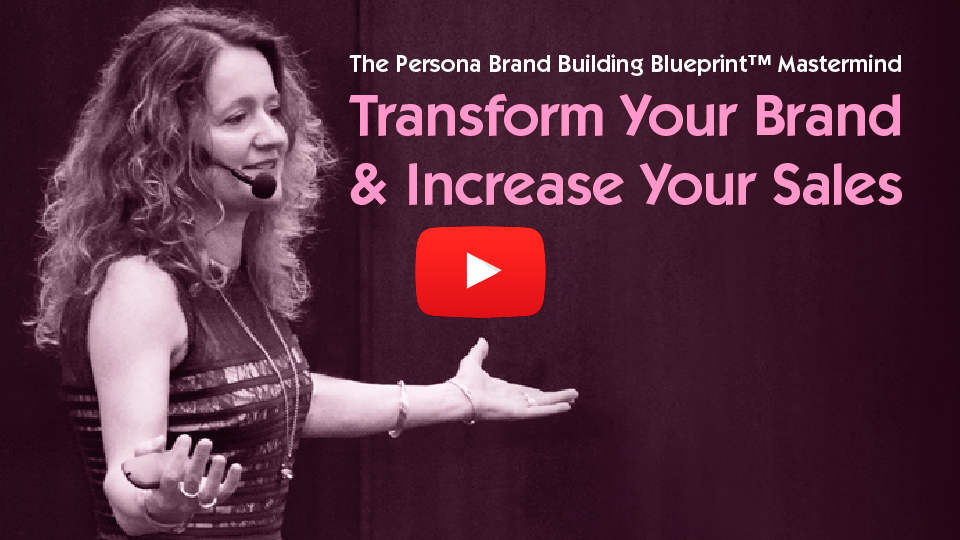
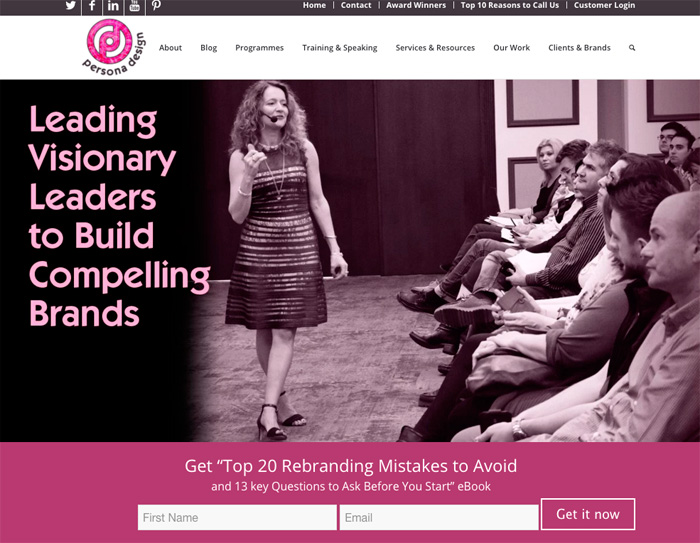


 Image via Gapingvoid, © Hugh MacLeod
Image via Gapingvoid, © Hugh MacLeod
